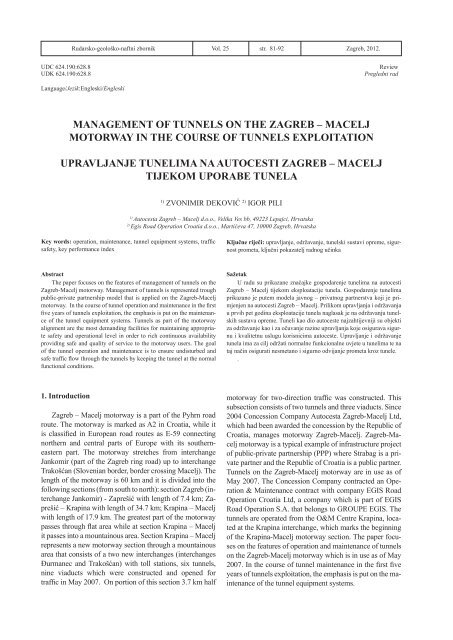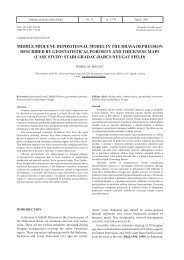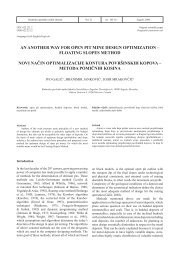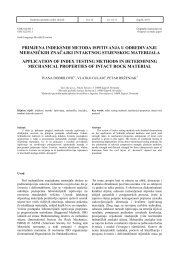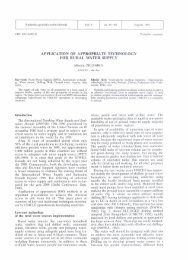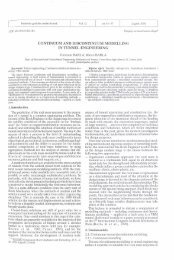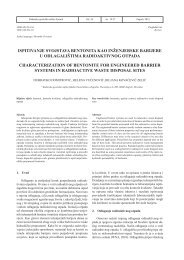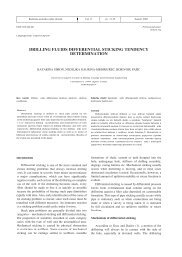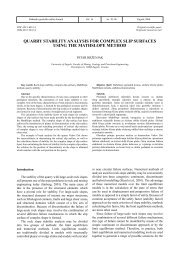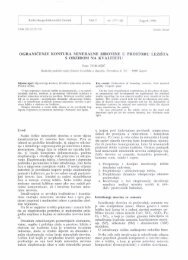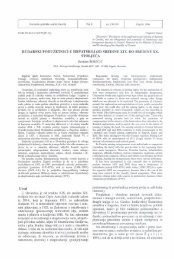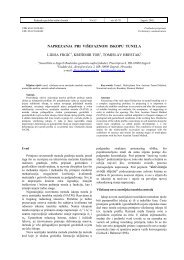management of tunnels on the zagreb – macelj motorway ... - Index of
management of tunnels on the zagreb – macelj motorway ... - Index of
management of tunnels on the zagreb – macelj motorway ... - Index of
You also want an ePaper? Increase the reach of your titles
YUMPU automatically turns print PDFs into web optimized ePapers that Google loves.
Rudarsko-geološko-naftni zbornik Vol. 25 str. 81-92 Zagreb, 2012.UDC 624.190:628.8UDK 624.190:628.8ReviewPregledni radLanguage/Jezik:Engleski/EngleskiMANAGEMENT OF TUNNELS ON THE ZAGREB <strong>–</strong> MACELJMOTORWAY IN THE COURSE OF TUNNELS EXPLOITATIONUPRAVLJANJE TUNELIMA NA AUTOCESTI ZAGREB <strong>–</strong> MACELJTIJEKOM UPORABE TUNELA1)ZVONIMIR DEKOVIĆ 2) IGOR PILI1)Autocesta Zagreb <strong>–</strong> Macelj d.o.o., Velika Ves bb, 49223 Lepajci, Hrvatska2)Egis Road Operati<strong>on</strong> Croatia d.o.o., Martićeva 47, 10000 Zagreb, HrvatskaKey words: operati<strong>on</strong>, maintenance, tunnel equipment systems, trafficsafety, key performance indexKljučne riječi: upravljanje, održavanje, tunelski sustavi opreme, sigurnostprometa, ključni pokazatelj radnog učinkaAbstractThe paper focuses <strong>on</strong> <strong>the</strong> features <str<strong>on</strong>g>of</str<strong>on</strong>g> <str<strong>on</strong>g>management</str<strong>on</strong>g> <str<strong>on</strong>g>of</str<strong>on</strong>g> <str<strong>on</strong>g>tunnels</str<strong>on</strong>g> <strong>on</strong> <strong>the</strong>Zagreb-Macelj <strong>motorway</strong>. Management <str<strong>on</strong>g>of</str<strong>on</strong>g> <str<strong>on</strong>g>tunnels</str<strong>on</strong>g> is represented troughpublic-private partnership model that is applied <strong>on</strong> <strong>the</strong> Zagreb-Macelj<strong>motorway</strong>. In <strong>the</strong> course <str<strong>on</strong>g>of</str<strong>on</strong>g> tunnel operati<strong>on</strong> and maintenance in <strong>the</strong> firstfive years <str<strong>on</strong>g>of</str<strong>on</strong>g> <str<strong>on</strong>g>tunnels</str<strong>on</strong>g> exploitati<strong>on</strong>, <strong>the</strong> emphasis is put <strong>on</strong> <strong>the</strong> maintenance<str<strong>on</strong>g>of</str<strong>on</strong>g> <strong>the</strong> tunnel equipment systems. Tunnels as part <str<strong>on</strong>g>of</str<strong>on</strong>g> <strong>the</strong> <strong>motorway</strong>alignment are <strong>the</strong> most demanding facilities for maintaining appropriatesafety and operati<strong>on</strong>al level in order to rich c<strong>on</strong>tinuous availabilityproviding safe and quality <str<strong>on</strong>g>of</str<strong>on</strong>g> service to <strong>the</strong> <strong>motorway</strong> users. The goal<str<strong>on</strong>g>of</str<strong>on</strong>g> <strong>the</strong> tunnel operati<strong>on</strong> and maintenance is to ensure undisturbed andsafe traffic flow through <strong>the</strong> <str<strong>on</strong>g>tunnels</str<strong>on</strong>g> by keeping <strong>the</strong> tunnel at <strong>the</strong> normalfuncti<strong>on</strong>al c<strong>on</strong>diti<strong>on</strong>s.SažetakU radu su prikazane značajke gospodarenje tunelima na autocestiZagreb <strong>–</strong> Macelj tijekom eksploatacije tunela. Gospodarenje tunelimaprikazano je putem modela javnog <strong>–</strong> privatnog partnerstva koji je primjenjenna autocesti Zagreb <strong>–</strong> Macelj. Prilikom upravljanja i održavanjau prvih pet godina eksploatacije tunela naglasak je na održavanju tunelskihsustava opreme. Tuneli kao dio autoceste najzahtijevniji su objektiza održavanje kao i za očuvanje razine upravljanja koje osigurava sigurnui kvalitetnu uslugu korisnicima autoceste. Upravljanje i održavanjetunela ima za cilj održati normalne funkci<strong>on</strong>alne uvjete u tunelima te nataj način osigurati nesmetano i sigurno odvijanje prometa kroz tunele..1. Introducti<strong>on</strong>Zagreb <strong>–</strong> Macelj <strong>motorway</strong> is a part <str<strong>on</strong>g>of</str<strong>on</strong>g> <strong>the</strong> Pyhrn roadroute. The <strong>motorway</strong> is marked as A2 in Croatia, while itis classified in European road routes as E-59 c<strong>on</strong>nectingnor<strong>the</strong>rn and central parts <str<strong>on</strong>g>of</str<strong>on</strong>g> Europe with its sou<strong>the</strong>rneasternpart. The <strong>motorway</strong> stretches from interchangeJankomir (part <str<strong>on</strong>g>of</str<strong>on</strong>g> <strong>the</strong> Zagreb ring road) up to interchangeTrakošćan (Slovenian border, border crossing Macelj). Thelength <str<strong>on</strong>g>of</str<strong>on</strong>g> <strong>the</strong> <strong>motorway</strong> is 60 km and it is divided into <strong>the</strong>following secti<strong>on</strong>s (from south to north): secti<strong>on</strong> Zagreb (interchangeJankomir) - Zaprešić with length <str<strong>on</strong>g>of</str<strong>on</strong>g> 7.4 km; Zaprešić<strong>–</strong> Krapina with length <str<strong>on</strong>g>of</str<strong>on</strong>g> 34.7 km; Krapina <strong>–</strong> Maceljwith length <str<strong>on</strong>g>of</str<strong>on</strong>g> 17.9 km. The greatest part <str<strong>on</strong>g>of</str<strong>on</strong>g> <strong>the</strong> <strong>motorway</strong>passes through flat area while at secti<strong>on</strong> Krapina <strong>–</strong> Maceljit passes into a mountainous area. Secti<strong>on</strong> Krapina <strong>–</strong> Maceljrepresents a new <strong>motorway</strong> secti<strong>on</strong> through a mountainousarea that c<strong>on</strong>sists <str<strong>on</strong>g>of</str<strong>on</strong>g> a two new interchanges (interchangesĐurmanec and Trakošćan) with toll stati<strong>on</strong>s, six <str<strong>on</strong>g>tunnels</str<strong>on</strong>g>,nine viaducts which were c<strong>on</strong>structed and opened fortraffic in May 2007. On porti<strong>on</strong> <str<strong>on</strong>g>of</str<strong>on</strong>g> this secti<strong>on</strong> 3.7 km half<strong>motorway</strong> for two-directi<strong>on</strong> traffic was c<strong>on</strong>structed. Thissubsecti<strong>on</strong> c<strong>on</strong>sists <str<strong>on</strong>g>of</str<strong>on</strong>g> two <str<strong>on</strong>g>tunnels</str<strong>on</strong>g> and three viaducts. Since2004 C<strong>on</strong>cessi<strong>on</strong> Company Autocesta Zagreb-Macelj Ltd,which had been awarded <strong>the</strong> c<strong>on</strong>cessi<strong>on</strong> by <strong>the</strong> Republic <str<strong>on</strong>g>of</str<strong>on</strong>g>Croatia, manages <strong>motorway</strong> Zagreb-Macelj. Zagreb-Macelj<strong>motorway</strong> is a typical example <str<strong>on</strong>g>of</str<strong>on</strong>g> infrastructure project<str<strong>on</strong>g>of</str<strong>on</strong>g> public-private partnership (PPP) where Strabag is a privatepartner and <strong>the</strong> Republic <str<strong>on</strong>g>of</str<strong>on</strong>g> Croatia is a public partner.Tunnels <strong>on</strong> <strong>the</strong> Zagreb-Macelj <strong>motorway</strong> are in use as <str<strong>on</strong>g>of</str<strong>on</strong>g>May 2007. The C<strong>on</strong>cessi<strong>on</strong> Company c<strong>on</strong>tracted an Operati<strong>on</strong>& Maintenance c<strong>on</strong>tract with company EGIS RoadOperati<strong>on</strong> Croatia Ltd, a company which is part <str<strong>on</strong>g>of</str<strong>on</strong>g> EGISRoad Operati<strong>on</strong> S.A. that bel<strong>on</strong>gs to GROUPE EGIS. The<str<strong>on</strong>g>tunnels</str<strong>on</strong>g> are operated from <strong>the</strong> O&M Centre Krapina, locatedat <strong>the</strong> Krapina interchange, which marks <strong>the</strong> beginning<str<strong>on</strong>g>of</str<strong>on</strong>g> <strong>the</strong> Krapina-Macelj <strong>motorway</strong> secti<strong>on</strong>. The paper focuses<strong>on</strong> <strong>the</strong> features <str<strong>on</strong>g>of</str<strong>on</strong>g> operati<strong>on</strong> and maintenance <str<strong>on</strong>g>of</str<strong>on</strong>g> <str<strong>on</strong>g>tunnels</str<strong>on</strong>g><strong>on</strong> <strong>the</strong> Zagreb-Macelj <strong>motorway</strong> which is in use as <str<strong>on</strong>g>of</str<strong>on</strong>g> May2007. In <strong>the</strong> course <str<strong>on</strong>g>of</str<strong>on</strong>g> tunnel maintenance in <strong>the</strong> first fiveyears <str<strong>on</strong>g>of</str<strong>on</strong>g> <str<strong>on</strong>g>tunnels</str<strong>on</strong>g> exploitati<strong>on</strong>, <strong>the</strong> emphasis is put <strong>on</strong> <strong>the</strong> maintenance<str<strong>on</strong>g>of</str<strong>on</strong>g> <strong>the</strong> tunnel equipment systems.
822. Operati<strong>on</strong> <str<strong>on</strong>g>of</str<strong>on</strong>g> <str<strong>on</strong>g>tunnels</str<strong>on</strong>g> <strong>on</strong> <strong>the</strong> Zagreb-Macelj<strong>motorway</strong>There are six <str<strong>on</strong>g>tunnels</str<strong>on</strong>g> <strong>on</strong> Zagreb <strong>–</strong> Macelj <strong>motorway</strong>.All six <str<strong>on</strong>g>tunnels</str<strong>on</strong>g> are located at secti<strong>on</strong> Krapina <strong>–</strong> Macelj.Table 1 shows lengths <str<strong>on</strong>g>of</str<strong>on</strong>g> <strong>the</strong> <str<strong>on</strong>g>tunnels</str<strong>on</strong>g>. On porti<strong>on</strong> <str<strong>on</strong>g>of</str<strong>on</strong>g> secti<strong>on</strong>Krapina <strong>–</strong> Macelj with length <str<strong>on</strong>g>of</str<strong>on</strong>g> 3.7 km half <strong>motorway</strong>was c<strong>on</strong>structed with two <str<strong>on</strong>g>tunnels</str<strong>on</strong>g> (Sv. Tri Kralja Tunneland Brezovica Tunnel) which have <strong>on</strong>e tunnel tube each.Both <str<strong>on</strong>g>tunnels</str<strong>on</strong>g> are c<strong>on</strong>structed for bidirecti<strong>on</strong>al traffic.O<strong>the</strong>r four <str<strong>on</strong>g>tunnels</str<strong>on</strong>g> have two tunnel tubes each, that is,<strong>the</strong>y are c<strong>on</strong>structed for full pr<str<strong>on</strong>g>of</str<strong>on</strong>g>ile <strong>motorway</strong>. As it ispresented in table 1, <str<strong>on</strong>g>tunnels</str<strong>on</strong>g>, Levačica, Vidovci, Đurmanecand Frukov Krč, less than 500 m in length have eachtunnel tube dedicated for <strong>on</strong>e traffic directi<strong>on</strong>. In total thatis ten traffic tunnel tubes and <strong>on</strong>e service tunnel tube.Rud.-geol.-naft. zb., Vol. 25, 2012.Z. Deković, I. Pili: Management <str<strong>on</strong>g>of</str<strong>on</strong>g> <str<strong>on</strong>g>tunnels</str<strong>on</strong>g>...tube <str<strong>on</strong>g>of</str<strong>on</strong>g> Sv. Tri Kralja Tunnel was c<strong>on</strong>structed <strong>on</strong>ly withprimary support with 20 cm thick shotcrete support, whilefinal c<strong>on</strong>crete lining was not envisaged. The service tube<str<strong>on</strong>g>of</str<strong>on</strong>g> Sv. Tri Kralja Tunnel has <strong>on</strong>e entry/exit portal <strong>on</strong> southside and it is c<strong>on</strong>nected to <strong>the</strong> traffic tunnel tube with fivecross passages for pedestrians from which three cross passagesserved for vehicles. This service tunnel tube servedlike evacuati<strong>on</strong> route in case <str<strong>on</strong>g>of</str<strong>on</strong>g> accident or unwantedevents for tunnel users and access for emergency vehiclesas well as operator’s service vehicles. Figure 2 shows servicetunnel tube <str<strong>on</strong>g>of</str<strong>on</strong>g> Sv. Tri Kralja tunnel.Table 1. Tunnels length in directi<strong>on</strong> south (Zagreb) <strong>–</strong> north (Macelj)Tablica 1. Dužina tunela u smjeru jug (Zagreb) <strong>–</strong> sjever (Macelj)TunnelRight Tunnel Tube Left Tunnel(m)Tube (m)Levačica 358 374Vidovci 261 266Sv. Tri Kralja 1740 1242 (service tube)Brezovica 590 not c<strong>on</strong>structedĐurmanec 204 204Frukov Krč 354 354Tunnel tubes are parallel with 25 m axis distance. Thefinal c<strong>on</strong>crete lining thickness amounts to 40 cm. The dimensi<strong>on</strong>s<str<strong>on</strong>g>of</str<strong>on</strong>g> tunnel clearance are 9.2 m in width and 4.5m in height, while <strong>the</strong> light opening is <str<strong>on</strong>g>of</str<strong>on</strong>g> 56.5 m 2 surface.Figure 1 shows typical view <strong>on</strong> tunnel tube <str<strong>on</strong>g>of</str<strong>on</strong>g> <str<strong>on</strong>g>tunnels</str<strong>on</strong>g> thatare c<strong>on</strong>structed for full pr<str<strong>on</strong>g>of</str<strong>on</strong>g>ile <strong>motorway</strong>.Figure 2. Sv. Tri Kralja Tunnel view <strong>on</strong> service tunnel tubeSlika 2. Pogled na sevisnu tunelsku cijev tunela Sv. Tri KraljaOn figure 3 is shown view <strong>on</strong> traffic tunnel tube <str<strong>on</strong>g>of</str<strong>on</strong>g>Sv. Tri Kralja Tunnel that is c<strong>on</strong>structed for bidirecti<strong>on</strong>altraffic.Figure 1. View <strong>on</strong> tunnel tubeSlika 1. Pogled na tunelsku cijevFigure 3. Sv. Tri Kralja Tunnel view <strong>on</strong> traffic tunnel tubeSlika 3. Pogled na prometnu tunelsku cijev tunela Sv. Tri KraljaThe left tunnel tube <str<strong>on</strong>g>of</str<strong>on</strong>g> Sv. Tri Kralja Tunnel was c<strong>on</strong>structedas a service tunnel tube (escape gallery) and <strong>the</strong>dimensi<strong>on</strong>s <str<strong>on</strong>g>of</str<strong>on</strong>g> tunnel clearance are 3.6 m in width and 3.5m in height, while <strong>the</strong> light opening is 18 m 2 . The service
Rud.-geol.-naft. zb., Vol. 25, 2012.Z. Deković, I. Pili: Management <str<strong>on</strong>g>of</str<strong>on</strong>g> <str<strong>on</strong>g>tunnels</str<strong>on</strong>g>...The <str<strong>on</strong>g>tunnels</str<strong>on</strong>g> are operated from <strong>the</strong> Operati<strong>on</strong> andMaintenance Centre Krapina, located at <strong>the</strong> Krapina interchange,which marks <strong>the</strong> beginning <str<strong>on</strong>g>of</str<strong>on</strong>g> <strong>the</strong> Krapina-Macelj<strong>motorway</strong> secti<strong>on</strong>. Operati<strong>on</strong> and Maintenance CentreKrapina is shown <strong>on</strong> figure 4.Figure 4. View <strong>on</strong> O&M Centre KrapinaSlika 4. Pogled na COKP KrapinaThe C<strong>on</strong>cessi<strong>on</strong> Company Autocesta Zagreb <strong>–</strong> MaceljLtd (<strong>the</strong> C<strong>on</strong>cessi<strong>on</strong>aire) is a special purpose companywith limited liability incorporated under <strong>the</strong> laws<str<strong>on</strong>g>of</str<strong>on</strong>g> Croatia and has been established to design, finance,c<strong>on</strong>struct, operate and maintain <strong>the</strong> Zagreb <strong>–</strong> Macelj<strong>motorway</strong>. The C<strong>on</strong>cessi<strong>on</strong> Company (<strong>the</strong> C<strong>on</strong>cessi<strong>on</strong>aire)subc<strong>on</strong>tracted operati<strong>on</strong> and maintenance <str<strong>on</strong>g>of</str<strong>on</strong>g> <strong>the</strong><strong>motorway</strong> under <strong>the</strong> Operati<strong>on</strong> and Maintenance C<strong>on</strong>tractto <strong>the</strong> company EGIS Road Operati<strong>on</strong> Croatia Ltd(<strong>the</strong> Operator), a company which is part <str<strong>on</strong>g>of</str<strong>on</strong>g> EGIS RoadOperati<strong>on</strong> S.A. that bel<strong>on</strong>gs to GROUPE EGIS. Figure 5shows relati<strong>on</strong>s and interacti<strong>on</strong>s between C<strong>on</strong>cessi<strong>on</strong>aire83and Operator. As it figure 5 has shown, <strong>the</strong> C<strong>on</strong>cessi<strong>on</strong>airemanages with strategic decisi<strong>on</strong>s <str<strong>on</strong>g>of</str<strong>on</strong>g> <str<strong>on</strong>g>tunnels</str<strong>on</strong>g> (<strong>the</strong> <strong>motorway</strong>),while <strong>the</strong> Operator carried out operati<strong>on</strong>al scope<str<strong>on</strong>g>of</str<strong>on</strong>g> resp<strong>on</strong>sibility. Resp<strong>on</strong>sibility <str<strong>on</strong>g>of</str<strong>on</strong>g> <strong>the</strong> C<strong>on</strong>cessi<strong>on</strong>aire iscarried out with extraordinary maintenance, renewal, enhancements,provisi<strong>on</strong> <str<strong>on</strong>g>of</str<strong>on</strong>g> spare parts, upgrading <str<strong>on</strong>g>of</str<strong>on</strong>g> tunnelequipment systems, follow up progress <str<strong>on</strong>g>of</str<strong>on</strong>g> operati<strong>on</strong> andmaintenance. Extraordinary maintenance, renewal andenhancement programme is prepared by <strong>the</strong> C<strong>on</strong>cessi<strong>on</strong>airewith assistance <str<strong>on</strong>g>of</str<strong>on</strong>g> <strong>the</strong> Operator. The C<strong>on</strong>cessi<strong>on</strong>aireis following up progress and performance standards <str<strong>on</strong>g>of</str<strong>on</strong>g><strong>the</strong> operati<strong>on</strong> and maintenance <str<strong>on</strong>g>of</str<strong>on</strong>g> <str<strong>on</strong>g>tunnels</str<strong>on</strong>g> (<strong>motorway</strong>) inaccordance with Operati<strong>on</strong> and Maintenance C<strong>on</strong>tract andimplementati<strong>on</strong> <str<strong>on</strong>g>of</str<strong>on</strong>g> <strong>the</strong> bylaws related to <strong>the</strong> operati<strong>on</strong> andmaintenance. The Operator is obligated to perform routinemaintenance (preventive and corrective maintenance) inaccordance with Operating and Maintenance plan. Operatingand Maintenance Plan has implied proposed acti<strong>on</strong>s by<strong>the</strong> Operator for performing operati<strong>on</strong> and maintenance <str<strong>on</strong>g>of</str<strong>on</strong>g><strong>motorway</strong> (<str<strong>on</strong>g>tunnels</str<strong>on</strong>g>). For each operating year <strong>the</strong> Operatoris developing operating and maintenance plan, which hasto be acceptable for <strong>the</strong> C<strong>on</strong>cessi<strong>on</strong>aire. Such yearly planis based <strong>on</strong> <strong>the</strong> bylaw, operati<strong>on</strong> and maintenance manuals,requirements and procedures. The Operator is c<strong>on</strong>tinuallyinforming <strong>the</strong> C<strong>on</strong>cessi<strong>on</strong>aire about status c<strong>on</strong>diti<strong>on</strong>s <str<strong>on</strong>g>of</str<strong>on</strong>g> <strong>the</strong>structures and <strong>the</strong> technical equipment <strong>on</strong> <strong>the</strong> <strong>motorway</strong>trough reports (m<strong>on</strong>thly, quarterly, annually), regular meetingsand notificati<strong>on</strong>s. Tunnels (<strong>motorway</strong>) operati<strong>on</strong> phaseis starting after c<strong>on</strong>structi<strong>on</strong> phase <str<strong>on</strong>g>of</str<strong>on</strong>g> <str<strong>on</strong>g>tunnels</str<strong>on</strong>g> is finished,test <strong>on</strong> completi<strong>on</strong> by Relevant Authority is successfullycarried out which resulted with issuing <str<strong>on</strong>g>of</str<strong>on</strong>g> use permit andfinally when <strong>the</strong> C<strong>on</strong>cessi<strong>on</strong> Company hand over <strong>the</strong> <strong>motorway</strong>to <strong>the</strong> Operator for operati<strong>on</strong> and maintenance <strong>the</strong>n<str<strong>on</strong>g>tunnels</str<strong>on</strong>g> are ready for use (open for traffic).Figure 5. Relati<strong>on</strong>s and interacti<strong>on</strong>s between <strong>the</strong> C<strong>on</strong>cessi<strong>on</strong>aire and <strong>the</strong> OperatorSlika 5. Odnosi i interakcije između k<strong>on</strong>cesi<strong>on</strong>ara i upravitelja
84Operati<strong>on</strong> <str<strong>on</strong>g>of</str<strong>on</strong>g> a tunnel requires, first and foremost, asystematic approach to undisturbed and safe traffic flowthrough <strong>the</strong> <str<strong>on</strong>g>tunnels</str<strong>on</strong>g>, which makes it necessary to optimizeall <strong>the</strong> parameters <str<strong>on</strong>g>of</str<strong>on</strong>g> <strong>the</strong> tunnel as a whole, rangingfrom tunnel equipment systems, through maintenance andm<strong>on</strong>itoring <str<strong>on</strong>g>of</str<strong>on</strong>g> tunnel structure, to <strong>the</strong> readiness to act incase <str<strong>on</strong>g>of</str<strong>on</strong>g> undesirable events.In case <str<strong>on</strong>g>of</str<strong>on</strong>g> <strong>the</strong> traffic safety, operati<strong>on</strong> <str<strong>on</strong>g>of</str<strong>on</strong>g> <str<strong>on</strong>g>tunnels</str<strong>on</strong>g> includefollowing basic factors: tunnel infrastructure (passivesafety measures), tunnel Operator (active safetymeasures), tunnel users, tunnel traffic structure and trafficvolume. Tunnel infrastructure or passive safety measuresmean tunnel structural features as well as tunnel equipmentsystems features. Tunnel structural features understandsnumber <str<strong>on</strong>g>of</str<strong>on</strong>g> tunnel tubes, geometry <str<strong>on</strong>g>of</str<strong>on</strong>g> tunnel, liningtype, escape gallery, cross passages numbers, drainagetypes, rock mass characteristics, excavati<strong>on</strong> method andsupport type etc. Tunnel equipment systems features includesinstalled equipment systems such as: tunnel lighting;tunnel ventilati<strong>on</strong> and CO, wind speed and visibilitydevices; fire detecti<strong>on</strong> system; traffic <str<strong>on</strong>g>management</str<strong>on</strong>g> system;tunnel SOS ph<strong>on</strong>es; public address loudspeaker; radio diffusi<strong>on</strong>system; CCTV (AID based) c<strong>on</strong>trol and supervisi<strong>on</strong>system (SCADA); tunnel UPS devices; water supplyand hydrant network system etc. The functi<strong>on</strong> <str<strong>on</strong>g>of</str<strong>on</strong>g> installedequipment is to improve road safety, while ensuring timelyand high-quality informati<strong>on</strong> for users and employeesregarding <strong>the</strong> c<strong>on</strong>diti<strong>on</strong>s <strong>on</strong> <strong>the</strong> <strong>motorway</strong>. Active safetymeasures represent operator’s procedures, implementati<strong>on</strong><str<strong>on</strong>g>of</str<strong>on</strong>g> this procedures, cooperati<strong>on</strong> and communicati<strong>on</strong>with emergency services, and maintenance <str<strong>on</strong>g>of</str<strong>on</strong>g> tunnel infrastructure.Operator’s procedures c<strong>on</strong>sisted standard operatingprocedures and emergency procedures. Standardoperating procedures are used for coordinati<strong>on</strong>, analysesand passing <strong>on</strong> <strong>the</strong> informati<strong>on</strong> ga<strong>the</strong>red from <strong>the</strong> varioustunnel equipment systems helping <strong>the</strong> Operator to make<strong>the</strong> right decisi<strong>on</strong>s in operati<strong>on</strong>al process.In standard operating procedures are defined activitiesneeded to be performed when operator is reporting malfuncti<strong>on</strong>and rectificati<strong>on</strong> <str<strong>on</strong>g>of</str<strong>on</strong>g> equipment. In order to ensurenormal and reliable operability <str<strong>on</strong>g>of</str<strong>on</strong>g> all tunnel systemswith minimum disturbance <str<strong>on</strong>g>of</str<strong>on</strong>g> <strong>the</strong> traffic, to protect dataintegrity and to reduce n<strong>on</strong> availability <str<strong>on</strong>g>of</str<strong>on</strong>g> <strong>the</strong> equipmentto minimum. As comp<strong>on</strong>ent (Pili, 2008) to Standard operatingprocedure with defect report and maintenance resp<strong>on</strong>seis Disaster Recovery procedure ensuring businessc<strong>on</strong>tingency <str<strong>on</strong>g>of</str<strong>on</strong>g> Zagreb <strong>–</strong> Macelj <strong>motorway</strong>.Emergency procedures are used for emergency casessuch as <strong>the</strong> accidents or undesirable events that representa serious interrupti<strong>on</strong> <str<strong>on</strong>g>of</str<strong>on</strong>g> traffic safety. Such cases requirequick implementati<strong>on</strong> <str<strong>on</strong>g>of</str<strong>on</strong>g> temporary measures or usage<str<strong>on</strong>g>of</str<strong>on</strong>g> resources until <strong>the</strong> end <str<strong>on</strong>g>of</str<strong>on</strong>g> <strong>the</strong> accident or interrupti<strong>on</strong>.In accordance with <strong>the</strong> bylaw, <strong>the</strong> Operator has <strong>the</strong> dutyto organize fire fighting duty, and fire fighting drills haveto be c<strong>on</strong>ducted in order to ensure <strong>the</strong> readiness <str<strong>on</strong>g>of</str<strong>on</strong>g> staffmembers and <strong>the</strong> functi<strong>on</strong>ality <str<strong>on</strong>g>of</str<strong>on</strong>g> <strong>the</strong> system in case <str<strong>on</strong>g>of</str<strong>on</strong>g>possible unwanted events. In <strong>the</strong> course <str<strong>on</strong>g>of</str<strong>on</strong>g> <strong>on</strong>e year, fiveRud.-geol.-naft. zb., Vol. 25, 2012.Z. Deković, I. Pili: Management <str<strong>on</strong>g>of</str<strong>on</strong>g> <str<strong>on</strong>g>tunnels</str<strong>on</strong>g>...“dry” drills are c<strong>on</strong>ducted (which includes checking <strong>the</strong>readiness to start <strong>the</strong> interventi<strong>on</strong> at <strong>the</strong> required speed,under full fire fighting equipment), as well as <strong>on</strong>e “wet”drill (where <strong>the</strong> simulati<strong>on</strong> includes unwanted events, toge<strong>the</strong>rwith <strong>the</strong> c<strong>on</strong>sequences <str<strong>on</strong>g>of</str<strong>on</strong>g> fire). Wet drills are c<strong>on</strong>ductedin <strong>the</strong> l<strong>on</strong>gest <str<strong>on</strong>g>tunnels</str<strong>on</strong>g>, Sv. Tri Kralja tunnel and/or Brezovica tunnel, both <str<strong>on</strong>g>of</str<strong>on</strong>g> which are <str<strong>on</strong>g>tunnels</str<strong>on</strong>g> with twowaytraffic. Each year, a different script <str<strong>on</strong>g>of</str<strong>on</strong>g> an accidentis prepared, and all <strong>the</strong> relevant services (Service 112;<strong>the</strong> police; emergency health service; public fire fightingunit; etc.) are included in <strong>the</strong> wet drill. Fur<strong>the</strong>rmore,when it comes to <str<strong>on</strong>g>tunnels</str<strong>on</strong>g> with two-way traffic, <strong>the</strong>re is anincreased level <str<strong>on</strong>g>of</str<strong>on</strong>g> maintenance <str<strong>on</strong>g>of</str<strong>on</strong>g> systems directly c<strong>on</strong>nectedwith fire protecti<strong>on</strong>, which is logical given <strong>the</strong> flow<str<strong>on</strong>g>of</str<strong>on</strong>g> activities aimed at <strong>the</strong> preventi<strong>on</strong> <str<strong>on</strong>g>of</str<strong>on</strong>g> unwanted events.The Operator is tackling <strong>the</strong> <str<strong>on</strong>g>tunnels</str<strong>on</strong>g> with two-way trafficwith even more attenti<strong>on</strong> than usual, precisely because <str<strong>on</strong>g>of</str<strong>on</strong>g><strong>the</strong> increased risk <str<strong>on</strong>g>of</str<strong>on</strong>g> unwanted events taking place.Maintenance <str<strong>on</strong>g>of</str<strong>on</strong>g> tunnel infrastructure represents <strong>on</strong>e <str<strong>on</strong>g>of</str<strong>on</strong>g><strong>the</strong> operati<strong>on</strong>al tools in <str<strong>on</strong>g>tunnels</str<strong>on</strong>g> operati<strong>on</strong>. It is carried outin accordance maintenance manual, requirements, bylawthat is included and amplified in operati<strong>on</strong> and maintenanceprocedures.Tunnel maintenance works can be divided into maintenanceworks <strong>on</strong> a tunnel as a structure <strong>on</strong> <strong>the</strong> <strong>on</strong>e hand,and, <strong>on</strong> <strong>the</strong> o<strong>the</strong>r hand, <strong>the</strong>re are <strong>the</strong> maintenance works<strong>on</strong> <strong>the</strong> tunnel equipment system. Maintenance works <strong>on</strong><str<strong>on</strong>g>tunnels</str<strong>on</strong>g> as structures include <strong>the</strong> following: tunnel inspecti<strong>on</strong>;tunnel cleaning; and c<strong>on</strong>structi<strong>on</strong> maintenance <str<strong>on</strong>g>of</str<strong>on</strong>g><strong>the</strong> tunnel. Tunnel inspecti<strong>on</strong>s can be periodical (e.g. seas<strong>on</strong>alinspecti<strong>on</strong>s and yearly inspecti<strong>on</strong>s), and <strong>the</strong>re arealso general tunnel inspecti<strong>on</strong>s, as well as extraordinaryinspecti<strong>on</strong>s. Periodical inspecti<strong>on</strong>s include <strong>the</strong> visual inspecti<strong>on</strong><str<strong>on</strong>g>of</str<strong>on</strong>g> <strong>the</strong> tunnel. Seas<strong>on</strong>al inspecti<strong>on</strong>s are performedafter <strong>the</strong> winter and summer periods (prior to and after<strong>the</strong> tourist seas<strong>on</strong>), and <strong>the</strong>y are undertaken in order toevaluate traffic safety and effectiveness <str<strong>on</strong>g>of</str<strong>on</strong>g> tunnel equipment,with <strong>the</strong> aim <str<strong>on</strong>g>of</str<strong>on</strong>g> recognizing certain characteristicsthat might point to damage. Annual inspecti<strong>on</strong> is c<strong>on</strong>ductedat least <strong>on</strong>ce every two years, in order to estimate<strong>the</strong> tunnel c<strong>on</strong>diti<strong>on</strong>, and to evaluate possible damage thattunnel elements might be exposed to. There is also <strong>the</strong>need to evaluate safety and usability <str<strong>on</strong>g>of</str<strong>on</strong>g> <strong>the</strong> tunnel in <strong>the</strong>coming period, until <strong>the</strong> next annual inspecti<strong>on</strong>. Generalinspecti<strong>on</strong> (Mlinarević, 2007) <str<strong>on</strong>g>of</str<strong>on</strong>g> tunnel as a structure isc<strong>on</strong>ducted at least <strong>on</strong>ce every six years. It includes a detailedinspecti<strong>on</strong> <str<strong>on</strong>g>of</str<strong>on</strong>g> <strong>the</strong> tunnel as structure, which is a taskperformed by <strong>the</strong> trained staff members <str<strong>on</strong>g>of</str<strong>on</strong>g> <strong>the</strong> Operator,toge<strong>the</strong>r with a specialized external expert company. Tunnelinspecti<strong>on</strong>s provide insight into possible damage andshortcomings <str<strong>on</strong>g>of</str<strong>on</strong>g> a tunnel, in terms <str<strong>on</strong>g>of</str<strong>on</strong>g> its structure stability,traffic safety, and <strong>the</strong> durability <str<strong>on</strong>g>of</str<strong>on</strong>g> tunnel structure.When it comes to tunnel cleaning, it includes cleaning<str<strong>on</strong>g>of</str<strong>on</strong>g> all <strong>the</strong> elements <str<strong>on</strong>g>of</str<strong>on</strong>g> <strong>the</strong> tunnel drainage system; cleaning<str<strong>on</strong>g>of</str<strong>on</strong>g> tunnel walls and tunnel equipment, accompaniedby tunnel washing. The cleaning <str<strong>on</strong>g>of</str<strong>on</strong>g> <strong>the</strong> tunnel drainagesystem is c<strong>on</strong>ducted periodically, with prior inspecti<strong>on</strong>s
Rud.-geol.-naft. zb., Vol. 25, 2012.Z. Deković, I. Pili: Management <str<strong>on</strong>g>of</str<strong>on</strong>g> <str<strong>on</strong>g>tunnels</str<strong>on</strong>g>...<str<strong>on</strong>g>of</str<strong>on</strong>g> <strong>the</strong> comprehensive drainage system. Drainage systems<str<strong>on</strong>g>of</str<strong>on</strong>g> dual-tube <str<strong>on</strong>g>tunnels</str<strong>on</strong>g> are cleaned in <strong>the</strong> following manner:two times per year sidewall drainage is cleaned toge<strong>the</strong>rwith <strong>the</strong> drainage <str<strong>on</strong>g>of</str<strong>on</strong>g> portal areas and portal structures.Lateral drainage c<strong>on</strong>necti<strong>on</strong>s in carriageway and <strong>the</strong> maindrainage (sewage system) are cleaned <strong>on</strong>ce per year. In<str<strong>on</strong>g>tunnels</str<strong>on</strong>g> with two-way traffic in a single tube <strong>the</strong> maindrainage (sewage system) is cleaned three times per year;sidewall drainage toge<strong>the</strong>r with additi<strong>on</strong>al drainage ininvert part is cleaned four times per year; lateral drainagec<strong>on</strong>necti<strong>on</strong>s in carriageway, and drainage <str<strong>on</strong>g>of</str<strong>on</strong>g> portalareas and portal structures are cleaned two times per year.The works required in <strong>the</strong> process <str<strong>on</strong>g>of</str<strong>on</strong>g> tunnel cleaning forsingle-tube <str<strong>on</strong>g>tunnels</str<strong>on</strong>g> with two-way traffic are coordinatedin such a way that <strong>the</strong> cleaning is performed exclusivelyat night, with traffic redirecti<strong>on</strong>. Depending <strong>on</strong> <strong>the</strong> findings<str<strong>on</strong>g>of</str<strong>on</strong>g> tunnel inspecti<strong>on</strong>, c<strong>on</strong>structi<strong>on</strong> maintenance <str<strong>on</strong>g>of</str<strong>on</strong>g> <strong>the</strong>tunnel may be needed. C<strong>on</strong>structi<strong>on</strong> maintenance <str<strong>on</strong>g>of</str<strong>on</strong>g> <strong>the</strong>tunnel includes regular and extraordinary maintenance.Routine maintenance pertains to <strong>the</strong> cleaning and smallerrepair works that are c<strong>on</strong>ducted in accordance with technicalrequirements. Extraordinary maintenance includes<strong>the</strong> works involving repair or rec<strong>on</strong>structi<strong>on</strong> <str<strong>on</strong>g>of</str<strong>on</strong>g> segments<str<strong>on</strong>g>of</str<strong>on</strong>g> <strong>the</strong> tunnel, or <strong>the</strong> tunnel as a whole, and such worksnecessitate <strong>the</strong> preparati<strong>on</strong> <str<strong>on</strong>g>of</str<strong>on</strong>g> technical documentati<strong>on</strong>.Operati<strong>on</strong> and maintenance documentati<strong>on</strong>s are issuedin accordance with envir<strong>on</strong>mental protecti<strong>on</strong> standardsrequested <strong>the</strong> bylaw and enforcement with <strong>the</strong> Envir<strong>on</strong>mentalManagement and Social Plan during operati<strong>on</strong> forZagreb <strong>–</strong> Macelj <strong>motorway</strong>.Actual traffic structure and traffic volume are essentialpart <str<strong>on</strong>g>of</str<strong>on</strong>g> tunnel operati<strong>on</strong>al process. Following and analysing<str<strong>on</strong>g>of</str<strong>on</strong>g> <strong>the</strong> traffic structure (c<strong>on</strong>tent <str<strong>on</strong>g>of</str<strong>on</strong>g> load traffic, buses,and dangerous goods traffic in overall daily or in periodicaltraffic and similar) and <strong>the</strong> traffic volume in <str<strong>on</strong>g>tunnels</str<strong>on</strong>g>are needed in order to reach required operati<strong>on</strong>al level inimplementati<strong>on</strong> <str<strong>on</strong>g>of</str<strong>on</strong>g> active safety measures in accordancewith actual traffic situati<strong>on</strong> in tunnel. Important place in<strong>the</strong> realisati<strong>on</strong> <str<strong>on</strong>g>of</str<strong>on</strong>g> <strong>the</strong> traffic safety in <str<strong>on</strong>g>tunnels</str<strong>on</strong>g> has transport<str<strong>on</strong>g>of</str<strong>on</strong>g> dangerous goods through <str<strong>on</strong>g>tunnels</str<strong>on</strong>g>. In accordancewith restricti<strong>on</strong>s <strong>on</strong> transport <str<strong>on</strong>g>of</str<strong>on</strong>g> dangerous goods through<str<strong>on</strong>g>tunnels</str<strong>on</strong>g> and categorizati<strong>on</strong> <str<strong>on</strong>g>of</str<strong>on</strong>g> <str<strong>on</strong>g>tunnels</str<strong>on</strong>g>, book <str<strong>on</strong>g>of</str<strong>on</strong>g> regulati<strong>on</strong>sfor transport <str<strong>on</strong>g>of</str<strong>on</strong>g> dangerous goods through is issued.This book <str<strong>on</strong>g>of</str<strong>on</strong>g> regulati<strong>on</strong>s for transport <str<strong>on</strong>g>of</str<strong>on</strong>g> dangerous goodsthrough <str<strong>on</strong>g>tunnels</str<strong>on</strong>g> is founded up<strong>on</strong> <strong>the</strong> bylaw and <strong>the</strong> EuropeanAgreement c<strong>on</strong>cerning <strong>the</strong> Internati<strong>on</strong>al Carriage <str<strong>on</strong>g>of</str<strong>on</strong>g>Dangerous Goods by Road (ADR). This book <str<strong>on</strong>g>of</str<strong>on</strong>g> regulati<strong>on</strong>sis related for <strong>the</strong> l<strong>on</strong>gest tunnel <strong>on</strong> Zagreb <strong>–</strong> Macelj<strong>motorway</strong> that is Sv. Tri Kralja tunnel. Fur<strong>the</strong>rmore, inyear 2011, in accordance with <strong>the</strong> new bylaw, <strong>the</strong> C<strong>on</strong>cessi<strong>on</strong>aireissued risk assessment for transportati<strong>on</strong> <str<strong>on</strong>g>of</str<strong>on</strong>g> dangerousgoods through <str<strong>on</strong>g>tunnels</str<strong>on</strong>g> l<strong>on</strong>ger than 500 m based<strong>on</strong> QRAM (Quantitative Risk Assessment Model). TheC<strong>on</strong>cessi<strong>on</strong>aire submitted risk assessment to <strong>the</strong> relevantauthority for c<strong>on</strong>firmati<strong>on</strong>.Traffic safety is str<strong>on</strong>gly depending <strong>on</strong> behaviour <str<strong>on</strong>g>of</str<strong>on</strong>g>tunnel users. Respecting <strong>the</strong> safety rules in tunnel as well85as usage <str<strong>on</strong>g>of</str<strong>on</strong>g> safety devices in case <str<strong>on</strong>g>of</str<strong>on</strong>g> accident or undesirableevents by tunnel users is crucial for safe tunnel useand <strong>the</strong> operati<strong>on</strong>al process. Informing users about <strong>the</strong>safety rules and usage <str<strong>on</strong>g>of</str<strong>on</strong>g> <strong>the</strong> safety devices in <str<strong>on</strong>g>tunnels</str<strong>on</strong>g> isimportant c<strong>on</strong>tributi<strong>on</strong> to <strong>the</strong> tunnel traffic safety. It is essentialthat users becoming familiar with <str<strong>on</strong>g>tunnels</str<strong>on</strong>g> like safetraffic structures.Besides menti<strong>on</strong>ed basic factors <strong>on</strong>e <str<strong>on</strong>g>of</str<strong>on</strong>g> essential toolin <str<strong>on</strong>g>tunnels</str<strong>on</strong>g> operati<strong>on</strong> and maintenance is transfer <str<strong>on</strong>g>of</str<strong>on</strong>g> dataand knowledge from design and c<strong>on</strong>structi<strong>on</strong> phase to<str<strong>on</strong>g>tunnels</str<strong>on</strong>g> operati<strong>on</strong> phase. Design documentati<strong>on</strong>s (main,detailed and as built design), records, tests and reportsabout quality <str<strong>on</strong>g>of</str<strong>on</strong>g> used materials and works during c<strong>on</strong>structi<strong>on</strong>represent basic data for operati<strong>on</strong> and maintenancephase. Keeping up with <strong>the</strong> latest technology developmentstoge<strong>the</strong>r with knowledge from design andtunnel c<strong>on</strong>structi<strong>on</strong> phase, is representing foundati<strong>on</strong> forstreng<strong>the</strong>ning <strong>the</strong> efficiency and permanently improving<strong>the</strong> level <str<strong>on</strong>g>of</str<strong>on</strong>g> operati<strong>on</strong>al practices.Exchanging <str<strong>on</strong>g>of</str<strong>on</strong>g> experience and informati<strong>on</strong> with o<strong>the</strong>rsC<strong>on</strong>cessi<strong>on</strong>aires and Operators in Croatia and Europe isalso <strong>the</strong> substantial tool for improving <strong>the</strong> operati<strong>on</strong>al level.In Croatia this is possible through <strong>the</strong> Croatian Associati<strong>on</strong><str<strong>on</strong>g>of</str<strong>on</strong>g> Toll Motorways C<strong>on</strong>cessi<strong>on</strong>aires (HUKA) thatis full member <str<strong>on</strong>g>of</str<strong>on</strong>g> ASECAP. The C<strong>on</strong>cessi<strong>on</strong> CompanyAutocesta Zagreb <strong>–</strong> Macelj Ltd is HUKA member. In accordancewith menti<strong>on</strong>ed basic factors, tunnel operati<strong>on</strong>shall be c<strong>on</strong>sider at <strong>the</strong> same time as complex and flexiblesystem that is based <strong>on</strong> four phase cycle: planning,implementati<strong>on</strong>, m<strong>on</strong>itoring and analysis as it is shownin figure 6.Figure 6. Tunnel operati<strong>on</strong> phasesSlika 6. Faze upravljanja tunelomFirst phase <str<strong>on</strong>g>of</str<strong>on</strong>g> cycle begin with planning. Planningphase includes development, evaluati<strong>on</strong> and establishment<str<strong>on</strong>g>of</str<strong>on</strong>g> operati<strong>on</strong>al plan as well as potential anticipatedimpacts and <strong>the</strong>ir assessment. It is c<strong>on</strong>tinued withrealisati<strong>on</strong> <str<strong>on</strong>g>of</str<strong>on</strong>g> operati<strong>on</strong>al plan. Realisati<strong>on</strong> <str<strong>on</strong>g>of</str<strong>on</strong>g> operati<strong>on</strong>alplan requires proper and timely maintenance <str<strong>on</strong>g>of</str<strong>on</strong>g> <strong>the</strong> safetyfacilities in <str<strong>on</strong>g>tunnels</str<strong>on</strong>g> that includes defect report and maintenanceresp<strong>on</strong>se. Active m<strong>on</strong>itoring <str<strong>on</strong>g>of</str<strong>on</strong>g> <strong>the</strong> realisati<strong>on</strong><str<strong>on</strong>g>of</str<strong>on</strong>g> <strong>the</strong> operati<strong>on</strong>al plan is following phase. Analysis <str<strong>on</strong>g>of</str<strong>on</strong>g>operati<strong>on</strong>al efficiency is carried out through m<strong>on</strong>itoringresults and performance indicators that are specific foreach phase <str<strong>on</strong>g>of</str<strong>on</strong>g> operati<strong>on</strong> process. From figure 6 emergentthat tunnel operati<strong>on</strong> covers two fundamental periods:period <str<strong>on</strong>g>of</str<strong>on</strong>g> preparati<strong>on</strong> <str<strong>on</strong>g>of</str<strong>on</strong>g> operati<strong>on</strong> (this is <strong>the</strong> period <str<strong>on</strong>g>of</str<strong>on</strong>g>selecti<strong>on</strong> and planning <str<strong>on</strong>g>of</str<strong>on</strong>g> technical and technological so-
86luti<strong>on</strong>s for operati<strong>on</strong>, and organizing <strong>the</strong> implementati<strong>on</strong><str<strong>on</strong>g>of</str<strong>on</strong>g> operati<strong>on</strong>) and period <str<strong>on</strong>g>of</str<strong>on</strong>g> actual operati<strong>on</strong> (introducti<strong>on</strong>and implementati<strong>on</strong> <str<strong>on</strong>g>of</str<strong>on</strong>g> selected technical and technologicalsoluti<strong>on</strong>s for operati<strong>on</strong> as well as organizati<strong>on</strong>al tunneloperati<strong>on</strong> structure; m<strong>on</strong>itoring and analysing <strong>the</strong> operati<strong>on</strong>).When we think <str<strong>on</strong>g>of</str<strong>on</strong>g> tunnel operati<strong>on</strong> as a comprehensivesystem, in which certain phases <str<strong>on</strong>g>of</str<strong>on</strong>g> operati<strong>on</strong> c<strong>on</strong>stituteseparate (sub)systems, it turns out that <strong>the</strong> optimumefficiency <str<strong>on</strong>g>of</str<strong>on</strong>g> a tunnel operati<strong>on</strong> system can be achieved<strong>on</strong>ly when we harm<strong>on</strong>ize <strong>the</strong> performance <str<strong>on</strong>g>of</str<strong>on</strong>g> all operati<strong>on</strong>functi<strong>on</strong>s, having in mind <strong>the</strong> goals inherent in <strong>the</strong> comprehensivesystem, ra<strong>the</strong>r than in separate parts. The efficiency<str<strong>on</strong>g>of</str<strong>on</strong>g> <strong>the</strong>se (sub) systems lies in <strong>the</strong> functi<strong>on</strong> <str<strong>on</strong>g>of</str<strong>on</strong>g> tunneloperati<strong>on</strong>. For successful tunnel operati<strong>on</strong>, it is importantto fulfil <strong>the</strong> goal <str<strong>on</strong>g>of</str<strong>on</strong>g> <strong>the</strong> whole, which means fulfilling <strong>the</strong>goal <str<strong>on</strong>g>of</str<strong>on</strong>g> <strong>the</strong> tunnel functi<strong>on</strong> per se: primarily ensuring anundisturbed and safe traffic flow through <strong>the</strong> tunnel.2.1. Risks in tunnel operati<strong>on</strong>Rud.-geol.-naft. zb., Vol. 25, 2012.Z. Deković, I. Pili: Management <str<strong>on</strong>g>of</str<strong>on</strong>g> <str<strong>on</strong>g>tunnels</str<strong>on</strong>g>...In general, key risks that are present in business activityand that are not necessarily c<strong>on</strong>nected with c<strong>on</strong>structi<strong>on</strong>,operati<strong>on</strong> and maintenance <str<strong>on</strong>g>of</str<strong>on</strong>g> <str<strong>on</strong>g>tunnels</str<strong>on</strong>g> can be described asfollows: political risk; ec<strong>on</strong>omic risk; legal risk; force ma-jeure risk; technical risk. The first four risks are generalrisks pertaining to all types <str<strong>on</strong>g>of</str<strong>on</strong>g> business activity. However,technical risk is a specific risk for underground c<strong>on</strong>structi<strong>on</strong>sand <str<strong>on</strong>g>tunnels</str<strong>on</strong>g>. Technical risks in <strong>the</strong> course <str<strong>on</strong>g>of</str<strong>on</strong>g> tunnellingcan be divided into three categories (Dudeck, 1987):risks in c<strong>on</strong>necti<strong>on</strong> with <strong>the</strong> task or purpose <str<strong>on</strong>g>of</str<strong>on</strong>g> tunnel, orrisks c<strong>on</strong>nected with mistakes and misjudgements, whichmakes it impossible to use <strong>the</strong> c<strong>on</strong>structed tunnel for itspurpose (functi<strong>on</strong>al risks); risks in c<strong>on</strong>necti<strong>on</strong> with <strong>the</strong>structure as c<strong>on</strong>structi<strong>on</strong> <strong>–</strong> mistakes and misjudgements inc<strong>on</strong>structi<strong>on</strong>s (especially primary support and final lining<str<strong>on</strong>g>of</str<strong>on</strong>g> a tunnel), which render it difficult or impossible to efficientlyc<strong>on</strong>struct <strong>the</strong> tunnel, but also to use it safely (c<strong>on</strong>structi<strong>on</strong>risks); risks in c<strong>on</strong>necti<strong>on</strong> with <strong>the</strong> c<strong>on</strong>tracting<str<strong>on</strong>g>of</str<strong>on</strong>g> tunnel works (c<strong>on</strong>tractual risks). The functi<strong>on</strong>al riskis particularly present in <strong>the</strong> course <str<strong>on</strong>g>of</str<strong>on</strong>g> tunnel operati<strong>on</strong>and maintenance, and we come across it in <strong>the</strong> course <str<strong>on</strong>g>of</str<strong>on</strong>g>tunnel exploitati<strong>on</strong> <strong>on</strong> a daily basis. Tunnel <str<strong>on</strong>g>management</str<strong>on</strong>g>has <strong>the</strong> aim <str<strong>on</strong>g>of</str<strong>on</strong>g> ensuring, first and foremost, unhinderedand safe traffic flow through <strong>the</strong> <str<strong>on</strong>g>tunnels</str<strong>on</strong>g>. In this c<strong>on</strong>text,it is necessary to optimize all parameters <str<strong>on</strong>g>of</str<strong>on</strong>g> <strong>the</strong> tunnel asa whole, ranging from tunnel equipment systems, to <strong>the</strong>maintenance and m<strong>on</strong>itoring <str<strong>on</strong>g>of</str<strong>on</strong>g> tunnel structure, as wellas readiness to act in case <str<strong>on</strong>g>of</str<strong>on</strong>g> undesirable events. The verygoal <str<strong>on</strong>g>of</str<strong>on</strong>g> tunnel operati<strong>on</strong> makes it necessary to manage<strong>the</strong> key risk: functi<strong>on</strong>al risk. Managing functi<strong>on</strong>al risk isbased <strong>on</strong> an interacti<strong>on</strong> <str<strong>on</strong>g>of</str<strong>on</strong>g> <strong>the</strong> four factors outlined above(passive and active safety measures; tunnel users; structureand volume <str<strong>on</strong>g>of</str<strong>on</strong>g> tunnel traffic), which impact up<strong>on</strong> <strong>the</strong>safety <str<strong>on</strong>g>of</str<strong>on</strong>g> tunnel traffic. Tunnel operati<strong>on</strong> in <strong>the</strong> course <str<strong>on</strong>g>of</str<strong>on</strong>g>exploitati<strong>on</strong> can be described using three fundamentalfactors: risk decisi<strong>on</strong>s, which are a c<strong>on</strong>sequence <str<strong>on</strong>g>of</str<strong>on</strong>g> decisi<strong>on</strong>-makingwithin <strong>the</strong> organizati<strong>on</strong> <str<strong>on</strong>g>of</str<strong>on</strong>g> tunnel operati<strong>on</strong>under <strong>the</strong> c<strong>on</strong>diti<strong>on</strong>s <str<strong>on</strong>g>of</str<strong>on</strong>g> risk; hazards as accidental events<str<strong>on</strong>g>of</str<strong>on</strong>g> any kind in <strong>the</strong> envir<strong>on</strong>ment, or within <strong>the</strong> <str<strong>on</strong>g>management</str<strong>on</strong>g>system; risk states in <strong>the</strong> <str<strong>on</strong>g>management</str<strong>on</strong>g> system andits envir<strong>on</strong>ment. These three fundamental factors <strong>–</strong> riskdecisi<strong>on</strong>s, hazards and risk states <strong>–</strong> simultaneously represent<strong>the</strong> causes <str<strong>on</strong>g>of</str<strong>on</strong>g> functi<strong>on</strong>al risk. Informati<strong>on</strong> and corresp<strong>on</strong>dingcommunicati<strong>on</strong>, present in <strong>the</strong> interacti<strong>on</strong> <str<strong>on</strong>g>of</str<strong>on</strong>g><strong>the</strong>se factors <str<strong>on</strong>g>of</str<strong>on</strong>g> tunnel operati<strong>on</strong>, represent <strong>the</strong> key sources<str<strong>on</strong>g>of</str<strong>on</strong>g> risk in tunnel operati<strong>on</strong>, or key sources <str<strong>on</strong>g>of</str<strong>on</strong>g> functi<strong>on</strong>alrisk. These three key causes <str<strong>on</strong>g>of</str<strong>on</strong>g> functi<strong>on</strong>al risk in tunneloperati<strong>on</strong> in <strong>the</strong> course <str<strong>on</strong>g>of</str<strong>on</strong>g> exploitati<strong>on</strong> also c<strong>on</strong>stitute <strong>the</strong>origin <str<strong>on</strong>g>of</str<strong>on</strong>g> various areas and sources <str<strong>on</strong>g>of</str<strong>on</strong>g> functi<strong>on</strong>al risk. Inthis c<strong>on</strong>text, we can emphasize <strong>the</strong> following: envir<strong>on</strong>ment(tunnel traffic) in which tunnel operati<strong>on</strong> is <strong>on</strong>going;<str<strong>on</strong>g>management</str<strong>on</strong>g> subjects, i.e. organizati<strong>on</strong>al tunnel operati<strong>on</strong>structure; informati<strong>on</strong> and corresp<strong>on</strong>ding communicati<strong>on</strong>within <strong>the</strong> operati<strong>on</strong> system, and including <strong>the</strong> envir<strong>on</strong>ment;safety <str<strong>on</strong>g>of</str<strong>on</strong>g> human beings and property within<strong>the</strong> <str<strong>on</strong>g>management</str<strong>on</strong>g> organizati<strong>on</strong>, and within <strong>the</strong> envir<strong>on</strong>ment(traffic). Given <strong>the</strong> fact that active safety measuresstem from <strong>the</strong> procedures <str<strong>on</strong>g>of</str<strong>on</strong>g> <strong>the</strong> Operator, <strong>the</strong> efficiency<str<strong>on</strong>g>of</str<strong>on</strong>g> passive safety measures stems from efficient maintenance<str<strong>on</strong>g>of</str<strong>on</strong>g> tunnel infrastructure, and all activities stemmingfrom safety measures are taking place during <strong>the</strong> use <str<strong>on</strong>g>of</str<strong>on</strong>g><strong>the</strong> tunnel (when traffic is in place). Therefore, we canc<strong>on</strong>clude that tunnel operati<strong>on</strong> risk is a functi<strong>on</strong>al risk,with maintenance risk and traffic risk as c<strong>on</strong>sequences.Based <strong>on</strong> <strong>the</strong> issues discussed above, we can define threekey functi<strong>on</strong>al risks in regard to tunnel operati<strong>on</strong>: tunneloperati<strong>on</strong> risk, tunnel maintenance risk, and tunnel trafficrisk. Tunnel operati<strong>on</strong> risk is a composite risk: tunnelmaintenance risk and tunnel traffic risk stem from it.After functi<strong>on</strong>al risk in tunnel operati<strong>on</strong> was identified,qualitative and quantitative analyses are following. Table2 presents features <str<strong>on</strong>g>of</str<strong>on</strong>g> functi<strong>on</strong>al risk in tunnel operati<strong>on</strong>in qualitative term. Functi<strong>on</strong>al risk in tunnel operati<strong>on</strong> isanalysed trough quantitative analysis in accordance withcauses, sources and c<strong>on</strong>sequences by such risk includes.Functi<strong>on</strong>al risk in tunnel operati<strong>on</strong>, in quantitative termsrepresents cost value in form <str<strong>on</strong>g>of</str<strong>on</strong>g> lost income. Lost incomeis c<strong>on</strong>sequence <str<strong>on</strong>g>of</str<strong>on</strong>g> issues such as: traffic jam; possibility <str<strong>on</strong>g>of</str<strong>on</strong>g>traffic accident or incident that would result in traffic jamand closure <str<strong>on</strong>g>of</str<strong>on</strong>g> <strong>the</strong> tunnel and/or entire <strong>motorway</strong> secti<strong>on</strong>;possible loss <str<strong>on</strong>g>of</str<strong>on</strong>g> traffic in <strong>the</strong> course <str<strong>on</strong>g>of</str<strong>on</strong>g> tunnel rec<strong>on</strong>structi<strong>on</strong>due to a traffic accident or incident; subsequent damageto <strong>the</strong> reputati<strong>on</strong> <str<strong>on</strong>g>of</str<strong>on</strong>g> <strong>the</strong> c<strong>on</strong>cessi<strong>on</strong> company; etc.
Rud.-geol.-naft. zb., Vol. 25, 2012.Z. Deković, I. Pili: Management <str<strong>on</strong>g>of</str<strong>on</strong>g> <str<strong>on</strong>g>tunnels</str<strong>on</strong>g>...87Table 2. Features <str<strong>on</strong>g>of</str<strong>on</strong>g> functi<strong>on</strong>al risk in tunnel operati<strong>on</strong> in qualitative termTablica 2. Obilježja funkci<strong>on</strong>alnog rizika upravljanja tunelom u kvaliativnom smisluTunnel operati<strong>on</strong> risk Tunnel maintenance risk Tunnel traffic riskRisk decisi<strong>on</strong>sfrom operati<strong>on</strong> and maintenance plan; from operators(adaptability to changes)in ordinary maintenance proceduresin traffic structure analysisCauseRisk statesactive safety measures (standard operative procedures,emergency procedures)terms <str<strong>on</strong>g>of</str<strong>on</strong>g> quality insurance inmaintenanceusers behaviour in traffic (respecting<str<strong>on</strong>g>of</str<strong>on</strong>g> safety rules in tunnel); operatorbehaviour during unwanted eventHazardsc<strong>on</strong>diti<strong>on</strong> <str<strong>on</strong>g>of</str<strong>on</strong>g> passive safety measures; frequency andintensity <str<strong>on</strong>g>of</str<strong>on</strong>g> traffic accident or undesirable eventstunnel infrastructure stateshare <str<strong>on</strong>g>of</str<strong>on</strong>g> dangerous goods in trafficstructureSource<str<strong>on</strong>g>management</str<strong>on</strong>g> subjects, organizati<strong>on</strong>al tunnel operati<strong>on</strong>structure (operator experience )envir<strong>on</strong>ment (tunnel traffic)<str<strong>on</strong>g>management</str<strong>on</strong>g> subjects,(organizati<strong>on</strong>al tunnel maintenancestructure)structure and volume <str<strong>on</strong>g>of</str<strong>on</strong>g> tunnel trafficC<strong>on</strong>sequenceendangers material and financial damage (tunnelclosure etc.); influence <strong>on</strong> safety (users and operatorsemployees)endangers financial damage;possible safety damageendangers material damage formpossible traffic accidents (destructi<strong>on</strong><str<strong>on</strong>g>of</str<strong>on</strong>g> tunnel infrastructure); possibleinjuries or death <str<strong>on</strong>g>of</str<strong>on</strong>g> users and/oroperators employeesC<strong>on</strong>sequently lost income stems from c<strong>on</strong>sequences<str<strong>on</strong>g>of</str<strong>on</strong>g> functi<strong>on</strong>al risk in tunnel operati<strong>on</strong>. Cost value <str<strong>on</strong>g>of</str<strong>on</strong>g> lostincome is carried out by comparing incomes for <strong>the</strong> same<strong>motorway</strong> secti<strong>on</strong> in cases when menti<strong>on</strong>ed secti<strong>on</strong> isopened and closed for traffic in certain period <str<strong>on</strong>g>of</str<strong>on</strong>g> time (i.e.for same m<strong>on</strong>th, week or day <str<strong>on</strong>g>of</str<strong>on</strong>g> last and current year etc.)and can be expressed as cost value per time e.g. HRK/m<strong>on</strong>th, HRK/day or HRK/hour etc.3. Maintenance <str<strong>on</strong>g>of</str<strong>on</strong>g> tunnel equipment systemsIn <strong>the</strong> course <str<strong>on</strong>g>of</str<strong>on</strong>g> tunnel maintenance in <strong>the</strong> first fiveyears <str<strong>on</strong>g>of</str<strong>on</strong>g> <str<strong>on</strong>g>tunnels</str<strong>on</strong>g> exploitati<strong>on</strong>, <strong>the</strong> emphasis is put <strong>on</strong> <strong>the</strong>maintenance <str<strong>on</strong>g>of</str<strong>on</strong>g> <strong>the</strong> tunnel equipment systems.Tunnels <strong>on</strong> Zagreb <strong>–</strong> Macelj <strong>motorway</strong> are designedin accordance with <strong>the</strong> regulati<strong>on</strong>s and <strong>the</strong> comprehensivelegal framework <str<strong>on</strong>g>of</str<strong>on</strong>g> <strong>the</strong> Republic <str<strong>on</strong>g>of</str<strong>on</strong>g> Croatia and Austriandirectives RVS issued in year 2002. According to we candivide <strong>the</strong>m into two groups, based <strong>on</strong> <strong>the</strong>ir length and <strong>the</strong>directi<strong>on</strong> <str<strong>on</strong>g>of</str<strong>on</strong>g> traffic. The first group c<strong>on</strong>sists <str<strong>on</strong>g>of</str<strong>on</strong>g> <str<strong>on</strong>g>tunnels</str<strong>on</strong>g> lessthan 500 m in length, with <strong>on</strong>e-way traffic where eachtunnel tube is dedicated for <strong>on</strong>e traffic directi<strong>on</strong>, that are<str<strong>on</strong>g>tunnels</str<strong>on</strong>g> Levačica, Vidovci, Đurmanec and Frukov Krč.The sec<strong>on</strong>d group c<strong>on</strong>sists <str<strong>on</strong>g>of</str<strong>on</strong>g> <str<strong>on</strong>g>tunnels</str<strong>on</strong>g> l<strong>on</strong>ger than 500m, with two-way traffic that are <str<strong>on</strong>g>tunnels</str<strong>on</strong>g>: Sv. Tri Kraljaand Brezovica. Tunnels <strong>on</strong> <strong>the</strong> Zagreb-Macelj <strong>motorway</strong>include <strong>the</strong> following installed equipment systems: tunnellighting; tunnel ventilati<strong>on</strong> and CO, wind speed and visibilitydevices; fire detecti<strong>on</strong> system; traffic <str<strong>on</strong>g>management</str<strong>on</strong>g>system; tunnel SOS ph<strong>on</strong>es; public address loudspeaker;radio diffusi<strong>on</strong> system; CCTV (AID based) c<strong>on</strong>troland supervisi<strong>on</strong> system (SCADA); tunnel UPS devices;water supply and hydrant network system. Accordingto <str<strong>on</strong>g>tunnels</str<strong>on</strong>g> length, table 3 outlines <strong>the</strong> share <str<strong>on</strong>g>of</str<strong>on</strong>g> variousequipment systems in tunnel groups. Maintenance <str<strong>on</strong>g>of</str<strong>on</strong>g>tunnel equipment systems, in a wider sense <str<strong>on</strong>g>of</str<strong>on</strong>g> <strong>the</strong> word,includes all <strong>the</strong> works necessary in order to determine <strong>the</strong>c<strong>on</strong>diti<strong>on</strong> <str<strong>on</strong>g>of</str<strong>on</strong>g> <strong>the</strong>se tunnel systems and <strong>the</strong>ir operati<strong>on</strong>al capacity,as well as all <strong>the</strong> works necessary to preserve <strong>the</strong>tunnel systems in technical working order.
88Table 3. Share <str<strong>on</strong>g>of</str<strong>on</strong>g> various equipment systems in <str<strong>on</strong>g>tunnels</str<strong>on</strong>g>Tablica 3. Podjela različitih sustava opreme u tunelimaTunnel equipment systemTunnels length 500 mTunnel electricity supply yes yesTunnel lighting yes yesTunnel ventilati<strong>on</strong> no yesCO, visibility and windspeed devicesnoyesfire detecti<strong>on</strong> yes yesTraffic <str<strong>on</strong>g>management</str<strong>on</strong>g> yes yesTunnel SOS ph<strong>on</strong>es (ERTsystem)no (<strong>on</strong>ly in portalareas)yesPublic address loudspeaker no yesRadio diffusi<strong>on</strong> no yesCCTVno (<strong>on</strong>ly in portalareas)yesCSS (SCADA) system yes yesTunnel ups system yes yesWater supply and hydrantnetworkMaintenance (Deković, 2011) <str<strong>on</strong>g>of</str<strong>on</strong>g> an individual systemc<strong>on</strong>sists <str<strong>on</strong>g>of</str<strong>on</strong>g> <strong>the</strong> works dedicated to routine maintenance,which are performed according to a certain maintenanceplan, and <strong>the</strong> works dedicated to extraordinary maintenance,which needs to be d<strong>on</strong>e urgently due to worsenedoperati<strong>on</strong>al and functi<strong>on</strong>al c<strong>on</strong>diti<strong>on</strong>s. The works <strong>on</strong>equipment system maintenance can be performed by staffnoyesRud.-geol.-naft. zb., Vol. 25, 2012.Z. Deković, I. Pili: Management <str<strong>on</strong>g>of</str<strong>on</strong>g> <str<strong>on</strong>g>tunnels</str<strong>on</strong>g>...members <str<strong>on</strong>g>of</str<strong>on</strong>g> <strong>the</strong> Operator, who have received expert trainingfor that purpose, and by external collaborators orcompanies as well; <strong>the</strong>se players can act independentlyor jointly, depending <strong>on</strong> <strong>the</strong> needs, and also depending<strong>on</strong> <strong>the</strong> type <str<strong>on</strong>g>of</str<strong>on</strong>g> facilities, specialized systems, devices andinstallati<strong>on</strong>s, and depending <strong>on</strong> <strong>the</strong> complexity <str<strong>on</strong>g>of</str<strong>on</strong>g> works.Routine system maintenance includes <strong>the</strong> following: regularinspecti<strong>on</strong>s, preventive maintenance works, correctivemaintenance works (smaller repair and replacement<str<strong>on</strong>g>of</str<strong>on</strong>g> worn parts); regular certificati<strong>on</strong>; measurement andtesting. Extraordinary maintenance <str<strong>on</strong>g>of</str<strong>on</strong>g> <strong>the</strong> equipmentsystem includes extraordinary inspecti<strong>on</strong>, renewal, andurgent interventi<strong>on</strong>s, which are performed urgently dueto worsened functi<strong>on</strong>al and operative c<strong>on</strong>diti<strong>on</strong>s in <strong>the</strong>system. Tunnel equipment systems are functi<strong>on</strong>al unitsthat toge<strong>the</strong>r create <strong>the</strong> comprehensive system for c<strong>on</strong>trol,<str<strong>on</strong>g>management</str<strong>on</strong>g> and safety <str<strong>on</strong>g>of</str<strong>on</strong>g> traffic in <strong>the</strong> <str<strong>on</strong>g>tunnels</str<strong>on</strong>g>. Safetymeasures provided by tunnel equipment systems shouldenable people involved in incidents to rescue <strong>the</strong>mselves,allow <strong>motorway</strong> users to act immediately so as to preventmore serious c<strong>on</strong>sequences, ensure that emergency servicescan act effectively and protect <strong>the</strong> envir<strong>on</strong>ment aswell as limit material damage. Recovery Point Objective(RPO), <strong>the</strong> acceptable level <str<strong>on</strong>g>of</str<strong>on</strong>g> system loss in distressedsituati<strong>on</strong> which needs to be recovered, is determined pereach tunnel system <str<strong>on</strong>g>of</str<strong>on</strong>g> Zagreb <strong>–</strong> Macelj <strong>motorway</strong> in MinimumOperating C<strong>on</strong>diti<strong>on</strong>s procedure. Minimum OperatingC<strong>on</strong>diti<strong>on</strong>s are defining measures to be undertakenper each system c<strong>on</strong>diti<strong>on</strong> described in four system states:nominal, bearable, critical, and endanger states which areshown in table 4.Table 4. Minimal Operati<strong>on</strong> C<strong>on</strong>diti<strong>on</strong>s statesTablica 4. Stanja minimalnih uvjeta upravljanjaState Definiti<strong>on</strong> <str<strong>on</strong>g>of</str<strong>on</strong>g> <strong>the</strong> state Measure to implement Impact/acti<strong>on</strong>System in normal functi<strong>on</strong>al___Nominal___c<strong>on</strong>diti<strong>on</strong>sDeferred Maintenance resp<strong>on</strong>se___BearableMinor system failurerequiredCriticalEndangerSignificant system failureMinimum operating c<strong>on</strong>diti<strong>on</strong>sendangeredUrgent Maintenance resp<strong>on</strong>serequiredUrgent Maintenance resp<strong>on</strong>serequiredAdditi<strong>on</strong>al safety measuresrequiredTunnel closureMaintenance and operati<strong>on</strong> <str<strong>on</strong>g>of</str<strong>on</strong>g> tunnel equipmentsystems based <strong>on</strong> Minimal Operating C<strong>on</strong>diti<strong>on</strong>s is representedin figure 7. As it is schematic represented in figure7, operati<strong>on</strong> and maintenance is based <strong>on</strong> informati<strong>on</strong> <strong>on</strong>current stage <str<strong>on</strong>g>of</str<strong>on</strong>g> <strong>the</strong> equipment system, relevant reacti<strong>on</strong>snecessary for maintaining <str<strong>on</strong>g>of</str<strong>on</strong>g> <strong>the</strong> high security levelsand reliable functi<strong>on</strong>ality <str<strong>on</strong>g>of</str<strong>on</strong>g> <strong>the</strong> comprehensive tunnelequipment system.
Rud.-geol.-naft. zb., Vol. 25, 2012.Z. Deković, I. Pili: Management <str<strong>on</strong>g>of</str<strong>on</strong>g> <str<strong>on</strong>g>tunnels</str<strong>on</strong>g>...89Figure 7. Tunnel equipment system minimum operating c<strong>on</strong>diti<strong>on</strong>s flowchartSlika 7. Dijagram toka minimalnih uvjeta upravljanja sustavima tunelske opremeIn terms <str<strong>on</strong>g>of</str<strong>on</strong>g> business c<strong>on</strong>tinuity aspect, undisturbedtraffic throughout Zagreb <strong>–</strong> Macelj <strong>motorway</strong>, <str<strong>on</strong>g>tunnels</str<strong>on</strong>g> are<strong>the</strong> most demanding facilities for maintaining appropriatesafety and operati<strong>on</strong>al level to in order to rich c<strong>on</strong>tinuousavailability. Operati<strong>on</strong>al and maintenance proceduresand measures are focused in that directi<strong>on</strong>. Tunnels involveshigh capital investment in c<strong>on</strong>structi<strong>on</strong>, operatingand maintenance cost in exploitati<strong>on</strong> but also very importantcost is for equipment and installati<strong>on</strong>s renewal whichhave service life far less <strong>the</strong>n tunnel structure. The relati<strong>on</strong>ship(PIARC, 2005) between <strong>the</strong> cost <str<strong>on</strong>g>of</str<strong>on</strong>g> maintenanceand <strong>the</strong> level <str<strong>on</strong>g>of</str<strong>on</strong>g> influence exercised <strong>on</strong> <strong>the</strong>se costs can beillustrated as it is shown in figure 8.Figure 8. Illustrati<strong>on</strong> <str<strong>on</strong>g>of</str<strong>on</strong>g> accumulated cost and corresp<strong>on</strong>ding level <str<strong>on</strong>g>of</str<strong>on</strong>g> influence <strong>on</strong> cost (PIARC, 2005)Slika 8. Prikaz akumuliranog troška i odgovarajuće razine utjecaja na trošak (PIARC, 2005)In general, <strong>the</strong> planning phase is normally 3 to 10 years,<strong>the</strong> c<strong>on</strong>structi<strong>on</strong> phase 2-3 years while <strong>the</strong> operati<strong>on</strong>alphase may be from 5 to 20 years for installati<strong>on</strong>s/systemsand 80 to 100 years for <strong>the</strong> tunnel structure. This doesnot include possible refurbishment activities. Life cycle<str<strong>on</strong>g>of</str<strong>on</strong>g> tunnel (technical) equipment systems is a point wherereplacement is appropriate ra<strong>the</strong>r <strong>the</strong>n c<strong>on</strong>tinued use inec<strong>on</strong>omic bases in relati<strong>on</strong> <str<strong>on</strong>g>of</str<strong>on</strong>g> operating and maintenancecost due to a greater risk <str<strong>on</strong>g>of</str<strong>on</strong>g> failure and unreliability increaseimpacting <strong>on</strong> safety level and endangering <str<strong>on</strong>g>tunnels</str<strong>on</strong>g>
90availability. Tunnel equipment systems life cycle depends<strong>on</strong> various external factors impacting significantly <strong>on</strong>realized life durati<strong>on</strong>. Systematic approach with comprehensivemethods, m<strong>on</strong>itoring and mitigati<strong>on</strong> <str<strong>on</strong>g>of</str<strong>on</strong>g> such factorsare essential in reaching intended life cycle durati<strong>on</strong>or even l<strong>on</strong>ger. Essential tools for reaching intended lifecycle durati<strong>on</strong> <str<strong>on</strong>g>of</str<strong>on</strong>g> tunnel technical equipment is implementati<strong>on</strong><str<strong>on</strong>g>of</str<strong>on</strong>g> preventive and corrective maintenance aswell as m<strong>on</strong>itoring <str<strong>on</strong>g>of</str<strong>on</strong>g> tunnel equipment systems errors. In<strong>the</strong> course <str<strong>on</strong>g>of</str<strong>on</strong>g> <strong>motorway</strong> operati<strong>on</strong> <str<strong>on</strong>g>tunnels</str<strong>on</strong>g> with two-wayRud.-geol.-naft. zb., Vol. 25, 2012.Z. Deković, I. Pili: Management <str<strong>on</strong>g>of</str<strong>on</strong>g> <str<strong>on</strong>g>tunnels</str<strong>on</strong>g>...traffic (Sv. Tri Kralja and Brezovica Tunnels) are representingpotential higher risk places <strong>on</strong> <strong>the</strong> <strong>motorway</strong> thano<strong>the</strong>r four <str<strong>on</strong>g>tunnels</str<strong>on</strong>g> that are c<strong>on</strong>structed for full <strong>motorway</strong>pr<str<strong>on</strong>g>of</str<strong>on</strong>g>ile. Therefore implementati<strong>on</strong> results <str<strong>on</strong>g>of</str<strong>on</strong>g> preventiveand corrective maintenance <str<strong>on</strong>g>of</str<strong>on</strong>g> tunnel equipment systemsis analysed for <strong>the</strong>se two <str<strong>on</strong>g>tunnels</str<strong>on</strong>g>. Figure 9 shows preventiveand corrective maintenance ratio <str<strong>on</strong>g>of</str<strong>on</strong>g> tunnel equipmentsystems from beginning <str<strong>on</strong>g>of</str<strong>on</strong>g> tunnel use in year 2007 untilyear 2011. Number <str<strong>on</strong>g>of</str<strong>on</strong>g> tunnel equipment systems failuresis shown in figure 10.Figure 9. Average ratio preventive and corrective maintenance per year <str<strong>on</strong>g>of</str<strong>on</strong>g> use Sv. Tri Kralja and Brezovica <str<strong>on</strong>g>tunnels</str<strong>on</strong>g>Slika 9. Prosječni odnos preventivnog i korektivnog održavanja po godini uporabe tunela Sv. Tri Kralja i BrezovicaFigure 10. Average number <str<strong>on</strong>g>of</str<strong>on</strong>g> equipment systems failures per year <str<strong>on</strong>g>of</str<strong>on</strong>g> use Sv. Tri Kralja and Brezovica <str<strong>on</strong>g>tunnels</str<strong>on</strong>g>Slika 10. Prosječni broj pogrešaka sustava opreme po godini uporabe tunela Sv. Tri Kralja i BrezovicaThe figures 9 and 10 make it clear that <strong>the</strong> number<str<strong>on</strong>g>of</str<strong>on</strong>g> equipment system failures were increased at <strong>the</strong> verybeginning <str<strong>on</strong>g>of</str<strong>on</strong>g> exploitati<strong>on</strong> <str<strong>on</strong>g>of</str<strong>on</strong>g> <strong>the</strong> <str<strong>on</strong>g>tunnels</str<strong>on</strong>g>. Therefore <strong>the</strong>need for interventi<strong>on</strong>s in <strong>the</strong> area <str<strong>on</strong>g>of</str<strong>on</strong>g> corrective maintenancewas also higher. Such a situati<strong>on</strong> is expected, given<strong>the</strong> fact that certain initial optimizati<strong>on</strong> <str<strong>on</strong>g>of</str<strong>on</strong>g> <strong>the</strong> system, or<strong>the</strong> “balancing” <str<strong>on</strong>g>of</str<strong>on</strong>g> individual systems, was necessary in<strong>the</strong> initial period <str<strong>on</strong>g>of</str<strong>on</strong>g> system use. In <strong>the</strong> following years <str<strong>on</strong>g>of</str<strong>on</strong>g>exploitati<strong>on</strong> <str<strong>on</strong>g>of</str<strong>on</strong>g> <strong>the</strong> <str<strong>on</strong>g>tunnels</str<strong>on</strong>g> it is visible trend <str<strong>on</strong>g>of</str<strong>on</strong>g> stabilizati<strong>on</strong><str<strong>on</strong>g>of</str<strong>on</strong>g> <strong>the</strong> average number <str<strong>on</strong>g>of</str<strong>on</strong>g> system failures, as well as <strong>the</strong>average number <str<strong>on</strong>g>of</str<strong>on</strong>g> corrective maintenance interventi<strong>on</strong>swhile efficiency <str<strong>on</strong>g>of</str<strong>on</strong>g> <strong>the</strong> preventive maintenance is increasing.3.1. Optimisati<strong>on</strong> <str<strong>on</strong>g>of</str<strong>on</strong>g> tunnel equipment systemsparametersAll inspecti<strong>on</strong>s and maintenance works with relatedmethods and techniques are managed and c<strong>on</strong>trolledtrough specialised Asset Management System. Based(Deković, 2011) <strong>on</strong> maintenance technical feedback abouttunnel equipment systems behaviour related per system
Rud.-geol.-naft. zb., Vol. 25, 2012.Rud.-geol.-naft. zb., Vol. 25, 2012.Z. Deković, I. Pili: Management <str<strong>on</strong>g>of</str<strong>on</strong>g> <str<strong>on</strong>g>tunnels</str<strong>on</strong>g>… 11Z. Deković, I. Pili: Management <str<strong>on</strong>g>of</str<strong>on</strong>g> <str<strong>on</strong>g>tunnels</str<strong>on</strong>g>… 11Rud.-geol.-naft.equipmentzb.,systemsVol. 25, 2012.Key Performance Indicators Reliability factor represents mean time betweenequipment Z. Deković, systems I. Pili: Management Key Performance <str<strong>on</strong>g>of</str<strong>on</strong>g> <str<strong>on</strong>g>tunnels</str<strong>on</strong>g>... Indicators Reliability factor represents mean time between 91(KPI’s) are following and analysing. A useful failures (MTBF). That is <strong>the</strong> predicted elapsed time(KPI’s) Rud.-geol.-naft.and Maintenanceare following zb., Vol.asset, tunnel’s Keyand 25, 2012.equipment Performanceanalysing.systems IndicatorsA usefulKey Performance (KPI’s)failuresbetween(MTBF).Reliability inherentThat isfactor represents failures<strong>the</strong> predictedmean <str<strong>on</strong>g>of</str<strong>on</strong>g> aelapsedtime systemtimebetween during failuresoperati<strong>on</strong>. inherentMaintenance Z. Deković,Indicators drives Key I. Pili:reliability Performance Management <str<strong>on</strong>g>of</str<strong>on</strong>g> <str<strong>on</strong>g>tunnels</str<strong>on</strong>g>…(KPI’s) are growth following while Indicatorsand guiding (KPI’s)analysing. <str<strong>on</strong>g>management</str<strong>on</strong>g> betweenA useful (MTBF). MTBF failuresThat is can <strong>the</strong> predicted be calculated <str<strong>on</strong>g>of</str<strong>on</strong>g> a systemelapsed as <strong>the</strong> time arithmetic during 11betweendrivesMaintenancereliability choices for growth improving Key Performancewhile maintenance guidingIndicators<str<strong>on</strong>g>management</str<strong>on</strong>g> effectiveness (KPI’s) drives and operati<strong>on</strong>.inherent mean failuresMTBF (average) <str<strong>on</strong>g>of</str<strong>on</strong>g>cana time systembe calculated between during failures operati<strong>on</strong>.as <strong>the</strong> arithmeticequipment systems Key Performance Indicators Reliability factor represents mean time between <str<strong>on</strong>g>of</str<strong>on</strong>g> MTBF a system. canchoices reliability for efficiency. (KPI’s)improvingare growth A following useful maintenance while maintenance and guiding effectivenessanalysing. <str<strong>on</strong>g>management</str<strong>on</strong>g> KPI identifies Aanduseful choices <strong>the</strong> mean be failures calculated The (average) (MTBF). as time (2) <strong>the</strong> That is arithmetic between <strong>the</strong> is sum <strong>the</strong> predicted <str<strong>on</strong>g>of</str<strong>on</strong>g> failures mean <strong>the</strong> operati<strong>on</strong>al (average) elapsed<str<strong>on</strong>g>of</str<strong>on</strong>g> a system.timeperiods be-efficiency. for issues Maintenance improving A useful causing Key maintenance Performance effectiveness KPI effects Indicators identifies and and (KPI’s) <strong>the</strong> helps efficiency. in The between MTBF divided failures inherent (2) by is <strong>the</strong> <str<strong>on</strong>g>of</str<strong>on</strong>g> <strong>the</strong> a number failures system. sum <str<strong>on</strong>g>of</str<strong>on</strong>g> <str<strong>on</strong>g>of</str<strong>on</strong>g> <str<strong>on</strong>g>of</str<strong>on</strong>g> The <strong>the</strong> observed a operati<strong>on</strong>al MTBF system failures (2) during is periods <strong>the</strong> and sum canissues A causing selecting drives reliabilityuseful maintenance <strong>the</strong> right growth strategy KPI effects whileidentifies to ei<strong>the</strong>r guiding and support <strong>the</strong> helps <str<strong>on</strong>g>management</str<strong>on</strong>g>issues or in correct causing divided operati<strong>on</strong>.<str<strong>on</strong>g>of</str<strong>on</strong>g> <strong>the</strong> be expressed: by operati<strong>on</strong>al <strong>the</strong> MTBF number can beperiods <str<strong>on</strong>g>of</str<strong>on</strong>g> calculated observed asdivided by failures <strong>the</strong> arithmetic<strong>the</strong> number and can <str<strong>on</strong>g>of</str<strong>on</strong>g> observedexpressed:choices for improving maintenance effectiveness and mean (average) time between failures <str<strong>on</strong>g>of</str<strong>on</strong>g> a system.selecting maintenance <strong>the</strong> <strong>the</strong> acti<strong>on</strong>s right strategy effects producing and to ei<strong>the</strong>r helps results. support in selecting Between or correct <strong>the</strong> right various, strategy<strong>on</strong>e to <str<strong>on</strong>g>of</str<strong>on</strong>g> ei<strong>the</strong>r most support important correct KPI’s <strong>the</strong> is acti<strong>on</strong>s availability producing factor. <strong>the</strong><str<strong>on</strong>g>of</str<strong>on</strong>g> downtime - start <str<strong>on</strong>g>of</str<strong>on</strong>g> uptime)beefficiency. A useful maintenance KPI identifies <strong>the</strong> The MTBF failures (2) and can be expressed:MTBF is <strong>the</strong> sum <str<strong>on</strong>g>of</str<strong>on</strong>g> <strong>the</strong> operati<strong>on</strong>al periods<strong>the</strong> acti<strong>on</strong>s issues producing causing <strong>the</strong> maintenance results. Between effects and various, helps divided by <strong>the</strong> (start number <str<strong>on</strong>g>of</str<strong>on</strong>g> observed failures and can (2)<strong>on</strong>e <str<strong>on</strong>g>of</str<strong>on</strong>g> results. <strong>the</strong> Availability selecting most Between important <strong>the</strong> right factor various, strategy KPI’s is comprised <strong>on</strong>e to <str<strong>on</strong>g>of</str<strong>on</strong>g> ei<strong>the</strong>r availability from support most two important factor.KPI’s correct KPI’s that be expressed: <str<strong>on</strong>g>of</str<strong>on</strong>g> downtime number-<str<strong>on</strong>g>of</str<strong>on</strong>g> start failures <str<strong>on</strong>g>of</str<strong>on</strong>g> uptime)MTBF (start (2) (2)is are <strong>the</strong> acti<strong>on</strong>savailability reliability producingfactor. factor <strong>the</strong>Availability (MTBF) results.factor and Betweenis maintainability various,Availability factor is comprised from two KPI’s comprised that fromnumber <str<strong>on</strong>g>of</str<strong>on</strong>g> failures<strong>on</strong>e <str<strong>on</strong>g>of</str<strong>on</strong>g> <strong>the</strong> most important KPI’s is availability factor.<str<strong>on</strong>g>of</str<strong>on</strong>g> downtime - start <str<strong>on</strong>g>of</str<strong>on</strong>g> uptime)two factor KPI’s (MTTR). that are reliability Availability factor factor (MTBF) is and implied MTBFmaintainability(MTTR). availability are reliability factor Availability (1) factor (MTTR). like <strong>the</strong> (MTBF) proporti<strong>on</strong> Availability factor and is <str<strong>on</strong>g>of</str<strong>on</strong>g> maintainabilityfactor time impliedis which implied Mean (MTTR) is a basic measure <str<strong>on</strong>g>of</str<strong>on</strong>g> <strong>the</strong> maintainability <str<strong>on</strong>g>of</str<strong>on</strong>g>Mean are reliability factor (MTBF) and maintainability(starttime to repair or maintainability (2) factorAvailability factor is comprised from two KPI’s thatnumber <str<strong>on</strong>g>of</str<strong>on</strong>g> failuresfactor Mean time to to repair repair or maintainability or maintainability factor factor (MTTR)availability availability <strong>the</strong> factor system (1) (MTTR). like (1) is <strong>the</strong> in like a proporti<strong>on</strong> Availability <strong>the</strong> functi<strong>on</strong>ing proporti<strong>on</strong> <str<strong>on</strong>g>of</str<strong>on</strong>g> c<strong>on</strong>diti<strong>on</strong>, factor time <str<strong>on</strong>g>of</str<strong>on</strong>g> time in is which <strong>the</strong> in implied which ratio <str<strong>on</strong>g>of</str<strong>on</strong>g> <strong>the</strong> (MTTR) repairable Mean items. It represents <strong>the</strong> average timeis a basic is a timemeasure basic to measure repair or<str<strong>on</strong>g>of</str<strong>on</strong>g> <strong>the</strong> maintainability <str<strong>on</strong>g>of</str<strong>on</strong>g> maintainability <strong>the</strong> maintainability factor<str<strong>on</strong>g>of</str<strong>on</strong>g> repairable <str<strong>on</strong>g>of</str<strong>on</strong>g><strong>the</strong> system system <strong>the</strong> availabilityis total in is in a time (1)functi<strong>on</strong>ing a a like functi<strong>on</strong>al <strong>the</strong> proporti<strong>on</strong>c<strong>on</strong>diti<strong>on</strong>, unit is <str<strong>on</strong>g>of</str<strong>on</strong>g><strong>the</strong> capable time in ratio <str<strong>on</strong>g>of</str<strong>on</strong>g> which<str<strong>on</strong>g>of</str<strong>on</strong>g>being (MTTR)<strong>the</strong> totalused time during a functi<strong>on</strong>al a given unit interval is is capable to <strong>the</strong> <str<strong>on</strong>g>of</str<strong>on</strong>g> <str<strong>on</strong>g>of</str<strong>on</strong>g> being length being used <str<strong>on</strong>g>of</str<strong>on</strong>g> <strong>the</strong> dur-<strong>the</strong> total corrective maintenance time divided by <strong>the</strong>required is a to basic repair measure a failed <str<strong>on</strong>g>of</str<strong>on</strong>g> comp<strong>on</strong>ent <strong>the</strong> maintainability or device. <str<strong>on</strong>g>of</str<strong>on</strong>g> It is<strong>the</strong> system is in a functi<strong>on</strong>ing c<strong>on</strong>diti<strong>on</strong>, <strong>the</strong> ratio <str<strong>on</strong>g>of</str<strong>on</strong>g>repairable items. repairable It represents items.items.ItIt <strong>the</strong> representsrepresents average time <strong>the</strong><strong>the</strong> required averageaverage to time repair time a<strong>the</strong> total <strong>the</strong> total time a functi<strong>on</strong>al unit is capable <str<strong>on</strong>g>of</str<strong>on</strong>g> beingfailed required comp<strong>on</strong>ent to repair or a failed device. comp<strong>on</strong>ent It is <strong>the</strong> total or or device. corrective It is It maintenance<strong>the</strong> total total time corrective divided maintenance by <strong>the</strong> total time number divided <str<strong>on</strong>g>of</str<strong>on</strong>g> by corrective by <strong>the</strong> <strong>the</strong>isused during interval. used a given a during givenTypical interval a given intervalavailability to <strong>the</strong> interval to length <strong>the</strong>objectives to <str<strong>on</strong>g>of</str<strong>on</strong>g> length <strong>the</strong> <strong>the</strong> length interval. are<str<strong>on</strong>g>of</str<strong>on</strong>g> <strong>the</strong>specified <str<strong>on</strong>g>of</str<strong>on</strong>g> Typical <strong>the</strong> <strong>the</strong> number <str<strong>on</strong>g>of</str<strong>on</strong>g> corrective maintenance acti<strong>on</strong>savailability ei<strong>the</strong>r interval. in Typical objectives decimal availability are fracti<strong>on</strong>s, specified objectives such ei<strong>the</strong>r as are in 0.9998, decimal specified fracti<strong>on</strong>s,sometimes ei<strong>the</strong>r such in as decimal in 0.9998, a logarithmic fracti<strong>on</strong>s, or sometimes unit such called in as a logarithmic 0.9998, nines, which or unit during (3): a given period <str<strong>on</strong>g>of</str<strong>on</strong>g> time and can be expressedor total during number a given <str<strong>on</strong>g>of</str<strong>on</strong>g> period corrective <str<strong>on</strong>g>of</str<strong>on</strong>g> time maintenance and can be acti<strong>on</strong>s expressedinterval. Typical availability objectives are specified total maintenance number acti<strong>on</strong>s <str<strong>on</strong>g>of</str<strong>on</strong>g> during a given period <str<strong>on</strong>g>of</str<strong>on</strong>g> acti<strong>on</strong>s time andei<strong>the</strong>r in sometimes decimal in fracti<strong>on</strong>s, a logarithmic such unit as called 0.9998, nines, which or during can (3): be a expressed given period (3): <str<strong>on</strong>g>of</str<strong>on</strong>g> time and can be expressedcalled corresp<strong>on</strong>ds nines, which roughly corresp<strong>on</strong>ds to a number roughly <str<strong>on</strong>g>of</str<strong>on</strong>g> nines to a following number <str<strong>on</strong>g>of</str<strong>on</strong>g>sometimes corresp<strong>on</strong>ds in a logarithmic roughly to unit a number called <str<strong>on</strong>g>of</str<strong>on</strong>g> nines, which following (3):nines <strong>the</strong> decimal following point, point, <strong>the</strong> such such decimal as as "five "five point, nines" nines" such for for as 0.99999. 0.99999. “five nines” It Ittotal corrective maintenance timecorresp<strong>on</strong>ds roughly to a number <str<strong>on</strong>g>of</str<strong>on</strong>g> followingtotal corrective maintenance timefor 0.99999. It is expressed with reliability factor (MTBF) andMTTR is expressed with reliability factor (MTBF) andMTTR (3) (3)<strong>the</strong> decimal total corrective maintenance acti<strong>on</strong>sand maintainability point, such factor as "fivefactor (MTTR):nines" for 0.99999. Ittotal(MTTR):corrective maintenance acti<strong>on</strong>stimeis expressed with reliability factor (MTBF) andMTTR (3)MTBFtotal corrective maintenance acti<strong>on</strong>smaintainability Availability factor (MTTR): MTBF (1)Availability MTBF MTTR (1) (1)MTBF MTTRMTBFAvailability (1)MTBF MTTRFigure 11. Tunnel equipment systems availability factor in Sv. Tri Kralja and Brezovica TunnelsSlika 11. Faktor korisnosti sustava tunelske opreme u tunelima Sv. Tri Kralja i BrezovicaFollowing <strong>the</strong> tunnel Figure equipment 11. Tunnel systems equipment availability systems availability <strong>the</strong> factor comprehensive in Sv. Tri Kralja system and Brezovica as a whole. Tunnels Analyzes <str<strong>on</strong>g>of</str<strong>on</strong>g>factor, presented in figure 11, is arising that systems <strong>the</strong> tunnel equipment systems throughout Keyare in proper functi<strong>on</strong>al c<strong>on</strong>diti<strong>on</strong> Slika 11. Faktor kept korisnosti <strong>on</strong> very sustava high tunelske Performance opreme u tunelima Indicators Sv. Tri Kralja represent i Brezovica <strong>on</strong>e <str<strong>on</strong>g>of</str<strong>on</strong>g> <strong>the</strong> steps inFigure availability 11. Tunnel level. equipment Figure There 11. systems Tunnel is also availability equipment visible factor systems functi<strong>on</strong>al in Sv. availability Tri Kralja factor and <strong>the</strong> Brezovica in Sv. optimisati<strong>on</strong> Tri Tunnels Kralja and <str<strong>on</strong>g>of</str<strong>on</strong>g> Brezovica tunnel Tunnels equipment systemsstabilisati<strong>on</strong> trend like it is shown in figures 9 and 10. parameters. Figure 12 is shown optimisati<strong>on</strong> processSlika 11. Faktor korisnosti sustava tunelske opreme u tunelima Sv. Tri Kralja i BrezovicaFollowing Such a stabilizati<strong>on</strong> <strong>the</strong> tunnel Slika trend 11. equipment Faktor stem korisnosti from systems high-qualitysustava availability tunelske opreme trough u tunelima c<strong>on</strong>tinuous Sv. Tri Kralja improvement i Brezovica cycle <str<strong>on</strong>g>of</str<strong>on</strong>g> <strong>the</strong>factor, routine presented maintenance figure that was 11, performed, is arising that given systems <strong>the</strong> operati<strong>on</strong> and maintenance <str<strong>on</strong>g>of</str<strong>on</strong>g> tunnel equipmentfact that routine maintenance is a foundati<strong>on</strong> <str<strong>on</strong>g>of</str<strong>on</strong>g> systems.are functi<strong>on</strong>ality in proper <str<strong>on</strong>g>of</str<strong>on</strong>g> functi<strong>on</strong>al each individual c<strong>on</strong>diti<strong>on</strong> system, kept but <strong>on</strong> very also <str<strong>on</strong>g>of</str<strong>on</strong>g> highFollowing availability Following<strong>the</strong> tunnel level. <strong>the</strong>equipmenttunnel There equipmentsystems is also visible systemsavailability functi<strong>on</strong>al availabilityfactor,factor,presented stabilisati<strong>on</strong>presentedin figure trendinlikefigure11, it is is11,arising shownis arisingin that figuresthatsystemssystems9 and 10.areare in proper Such functi<strong>on</strong>al a stabilizati<strong>on</strong> c<strong>on</strong>diti<strong>on</strong> trend kept stem <strong>on</strong> from very high-qualityin proper functi<strong>on</strong>al c<strong>on</strong>diti<strong>on</strong> kept <strong>on</strong> very high availabilitylevel. There is also visible functi<strong>on</strong>al stabilisati<strong>on</strong>availability routine level. maintenance There is that also was visible performed, functi<strong>on</strong>al given <strong>the</strong>stabilisati<strong>on</strong> fact trend that like routine it is maintenance shown figures is a 9 foundati<strong>on</strong> and 10. <str<strong>on</strong>g>of</str<strong>on</strong>g>trend like it is shown in figures 9 and 10. Such a stabilizati<strong>on</strong>trend stem from high-quality routine maintenanceSuch a functi<strong>on</strong>ality stabilizati<strong>on</strong> <str<strong>on</strong>g>of</str<strong>on</strong>g> trend each stem individual from system, high-quality but also <str<strong>on</strong>g>of</str<strong>on</strong>g>routine maintenance that was performed, given <strong>the</strong>that was performed, given <strong>the</strong> fact that routine maintenanceis a foundati<strong>on</strong> <str<strong>on</strong>g>of</str<strong>on</strong>g> functi<strong>on</strong>ality <str<strong>on</strong>g>of</str<strong>on</strong>g> each individualfact that routine maintenance is a foundati<strong>on</strong> <str<strong>on</strong>g>of</str<strong>on</strong>g>functi<strong>on</strong>ality <str<strong>on</strong>g>of</str<strong>on</strong>g> each individual system, but also <str<strong>on</strong>g>of</str<strong>on</strong>g><strong>the</strong> comprehensive system as a whole. Analyzes <str<strong>on</strong>g>of</str<strong>on</strong>g><strong>the</strong> tunnel equipment systems throughout KeyPerformance Indicators represent <strong>on</strong>e <str<strong>on</strong>g>of</str<strong>on</strong>g> <strong>the</strong> steps in<strong>the</strong> comprehensive <strong>the</strong> optimisati<strong>on</strong> system <str<strong>on</strong>g>of</str<strong>on</strong>g> as tunnel a whole. equipment Analyzes systems <str<strong>on</strong>g>of</str<strong>on</strong>g>system, but also <str<strong>on</strong>g>of</str<strong>on</strong>g> <strong>the</strong> comprehensive system as a whole.<strong>the</strong> tunnel parameters. equipment Figure 12 systems is shown throughout optimisati<strong>on</strong> process KeyAnalyzes <str<strong>on</strong>g>of</str<strong>on</strong>g> <strong>the</strong> tunnel equipment systems throughoutPerformance trough Indicators c<strong>on</strong>tinuous represent improvement <strong>on</strong>e <str<strong>on</strong>g>of</str<strong>on</strong>g> cycle <strong>the</strong> steps <str<strong>on</strong>g>of</str<strong>on</strong>g> in <strong>the</strong>Key Performance Indicators represent <strong>on</strong>e <str<strong>on</strong>g>of</str<strong>on</strong>g> <strong>the</strong> steps in<strong>the</strong> operati<strong>on</strong> optimisati<strong>on</strong> and <str<strong>on</strong>g>of</str<strong>on</strong>g> maintenance tunnel equipment <str<strong>on</strong>g>of</str<strong>on</strong>g> tunnel systems equipment<strong>the</strong> optimisati<strong>on</strong> <str<strong>on</strong>g>of</str<strong>on</strong>g> tunnel equipment systems parameters.parameters. systems. Figure 12 is shown optimisati<strong>on</strong> processFigure 12 is shown optimisati<strong>on</strong> process trough c<strong>on</strong>tinuousimprovement cycle <str<strong>on</strong>g>of</str<strong>on</strong>g> <strong>the</strong> operati<strong>on</strong> and maintenancetrough c<strong>on</strong>tinuous improvement cycle <str<strong>on</strong>g>of</str<strong>on</strong>g> <strong>the</strong>operati<strong>on</strong> and maintenance <str<strong>on</strong>g>of</str<strong>on</strong>g> tunnel equipment<str<strong>on</strong>g>of</str<strong>on</strong>g> tunnel equipment systems.systems.
92Rud.-geol.-naft. zb., Vol. 25, 2012.Z. Deković, I. Pili: Management <str<strong>on</strong>g>of</str<strong>on</strong>g> <str<strong>on</strong>g>tunnels</str<strong>on</strong>g>...Figure 12. Tunnel equipment systems parameters optimisati<strong>on</strong> cycleSlika 12. Proces optimizacije parametara tunelske opremeFor each individual tunnel equipment system, aswell as <strong>the</strong> comprehensive system as a whole, followingphases <str<strong>on</strong>g>of</str<strong>on</strong>g> optimisati<strong>on</strong> comprised in optimisati<strong>on</strong> cycle asshown in figure 12 are carried out: observati<strong>on</strong> <str<strong>on</strong>g>of</str<strong>on</strong>g> <strong>the</strong> tunnelequipment systems throughout system m<strong>on</strong>itoring andsupervisi<strong>on</strong>, regular inspecti<strong>on</strong>s and routine maintenance;assessment <str<strong>on</strong>g>of</str<strong>on</strong>g> <strong>the</strong> tunnel equipment systems c<strong>on</strong>diti<strong>on</strong>trough Key Performance Indicators, inspecti<strong>on</strong> and maintenanceanalyses; work identificati<strong>on</strong>; planning, schedulingand executi<strong>on</strong> <str<strong>on</strong>g>of</str<strong>on</strong>g> work, follow up. Optimisati<strong>on</strong> cyclerepresents systematic approach to <strong>the</strong> operati<strong>on</strong> and maintenance<str<strong>on</strong>g>of</str<strong>on</strong>g> <strong>the</strong> tunnel equipment systems that is foundati<strong>on</strong>for accomplished <str<strong>on</strong>g>of</str<strong>on</strong>g> <strong>the</strong> high safety level <str<strong>on</strong>g>of</str<strong>on</strong>g> tunnelc<strong>on</strong>diti<strong>on</strong>s and functi<strong>on</strong>ality <str<strong>on</strong>g>of</str<strong>on</strong>g> tunnel equipment systems.4. C<strong>on</strong>clusi<strong>on</strong>In terms <str<strong>on</strong>g>of</str<strong>on</strong>g> business c<strong>on</strong>tinuity aspect, undisturbedtraffic throughout Zagreb <strong>–</strong> Macelj <strong>motorway</strong>, <str<strong>on</strong>g>tunnels</str<strong>on</strong>g> are<strong>the</strong> most demanding facilities for maintaining appropriatesafety and operati<strong>on</strong>al level in order to rich c<strong>on</strong>tinuousavailability. Tunnels operati<strong>on</strong> is complex and demandactivity that requires <strong>the</strong> systematic approach to undisturbedand safe traffic flow through <strong>the</strong> <str<strong>on</strong>g>tunnels</str<strong>on</strong>g>. As result <str<strong>on</strong>g>of</str<strong>on</strong>g><strong>the</strong> systematic approach stems <strong>the</strong> optimised operati<strong>on</strong>altunnel system that ensures maximum efficiency in tunneloperati<strong>on</strong> and maintenance. Maintenance <str<strong>on</strong>g>of</str<strong>on</strong>g> <str<strong>on</strong>g>tunnels</str<strong>on</strong>g>, as<strong>on</strong>e <str<strong>on</strong>g>of</str<strong>on</strong>g> operati<strong>on</strong>al tools, and in particular <strong>the</strong> maintenance<str<strong>on</strong>g>of</str<strong>on</strong>g> tunnel equipment systems, requires a high quality <str<strong>on</strong>g>of</str<strong>on</strong>g>services in terms <str<strong>on</strong>g>of</str<strong>on</strong>g> resp<strong>on</strong>se time in case <str<strong>on</strong>g>of</str<strong>on</strong>g> malfuncti<strong>on</strong>,undesirable event or accident in a tunnel. Active m<strong>on</strong>itoring<str<strong>on</strong>g>of</str<strong>on</strong>g> each individual system and <str<strong>on</strong>g>of</str<strong>on</strong>g> <strong>the</strong> tunnel equipmentsystem as a whole throughout Key Performance Indicatorsrepresents basis for optimised operati<strong>on</strong> <str<strong>on</strong>g>of</str<strong>on</strong>g> <strong>the</strong> tunnelequipment systems. Optimised operati<strong>on</strong>al tunnel systemis representing answer <strong>on</strong> identified and analysed functi<strong>on</strong>alrisks in tunnel operati<strong>on</strong>. The C<strong>on</strong>cessi<strong>on</strong>aire and<strong>the</strong> Operator are dedicated to streng<strong>the</strong>ning <strong>the</strong> efficiencyand permanently improving <strong>the</strong> level <str<strong>on</strong>g>of</str<strong>on</strong>g> services providedto <strong>the</strong> <strong>motorway</strong> users by keeping up with <strong>the</strong> latest technologydevelopments and <strong>the</strong> best operati<strong>on</strong>al practices.5. ReferencesDeković, Z., Cviljak, B., (2011): Fundamental Characteristics <str<strong>on</strong>g>of</str<strong>on</strong>g> Tunnellingand Tunnel Maintenance <strong>on</strong> <strong>the</strong> Zagreb-Macelj Motorway,Proceedings <str<strong>on</strong>g>of</str<strong>on</strong>g> <strong>the</strong> 1 st Internati<strong>on</strong>al C<strong>on</strong>gress <strong>on</strong> Tunnels and UndergroundStructures in South-East Europe Using underground space,Dubrovnik, Croatia, pp. 78-79Deković, Z., Pili, I., (2011): Optimisati<strong>on</strong> <str<strong>on</strong>g>of</str<strong>on</strong>g> <strong>the</strong> operati<strong>on</strong> and <strong>the</strong> maintenance<str<strong>on</strong>g>of</str<strong>on</strong>g> <strong>the</strong> tunnel equipment systems <strong>on</strong> <strong>the</strong> Zagreb-Macelj <strong>motorway</strong>,Proceedings <str<strong>on</strong>g>of</str<strong>on</strong>g> <strong>the</strong> 10 th Internati<strong>on</strong>al Symposium <strong>on</strong> TunnelC<strong>on</strong>structi<strong>on</strong> and Underground Structures, Ljubljana, Slovenia, pp.140-145Duddeck, H., (1987): Risk Assessment and Risk Sharing in Tunneling,Tunnelling and Underground Space Technology, Vol. 2. No. 3, pp.315 <strong>–</strong> 317Mlinarević, I., Klarić, S., (2007): Standard redovnog održavanja autocesta1, Hrvatske autoceste, Zagreb, pp. 81-86PIARC (2005): Good Practice for <strong>the</strong> Operati<strong>on</strong> and Maintenance <str<strong>on</strong>g>of</str<strong>on</strong>g>Road Tunnels, PIARC Committee <strong>on</strong> Road Tunnel Operati<strong>on</strong> (C5),pp. 47-49Pili, I., Skiba, H., (2008): Standard operating procedure defect reportand maintenance resp<strong>on</strong>se and disaster recovery procedure <str<strong>on</strong>g>of</str<strong>on</strong>g>equipment maintenance <str<strong>on</strong>g>of</str<strong>on</strong>g> Zagreb <strong>–</strong> Macelj <strong>motorway</strong>, Egis RoadOperati<strong>on</strong> Croatia Ltd, Zagreb, Croatia, pp. 6-9


